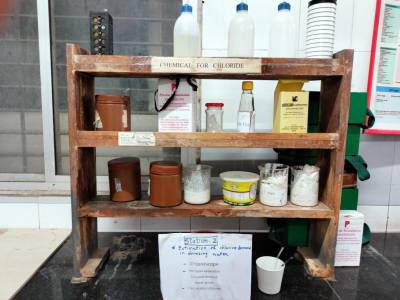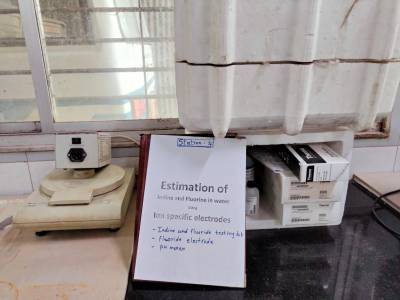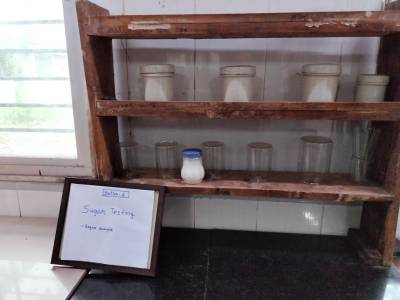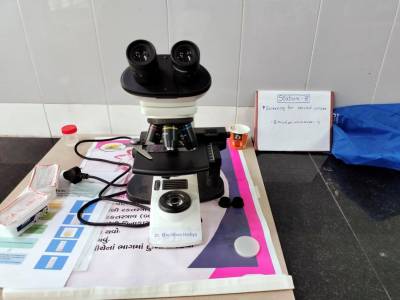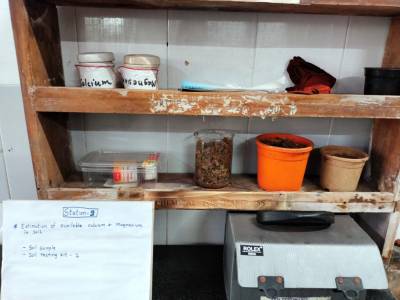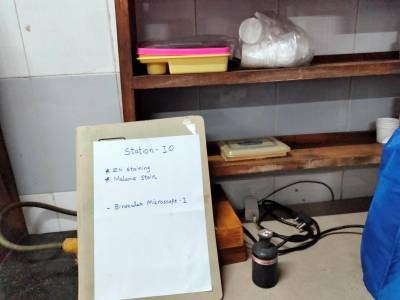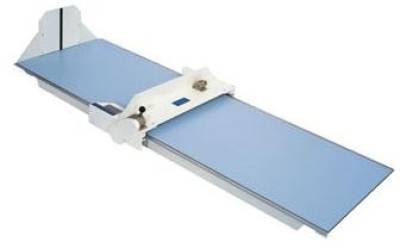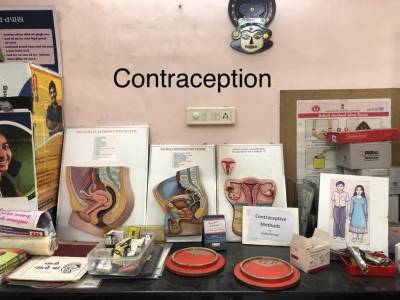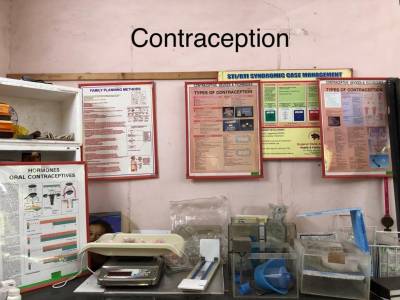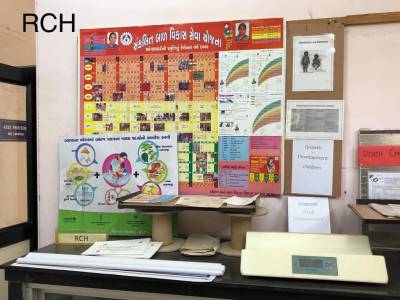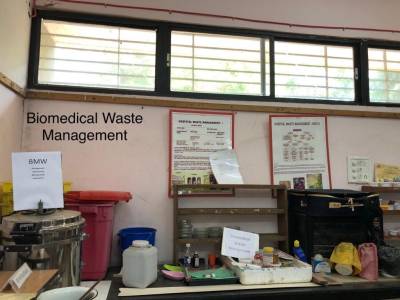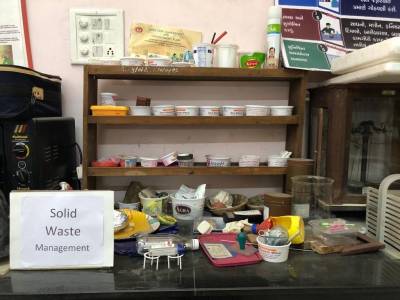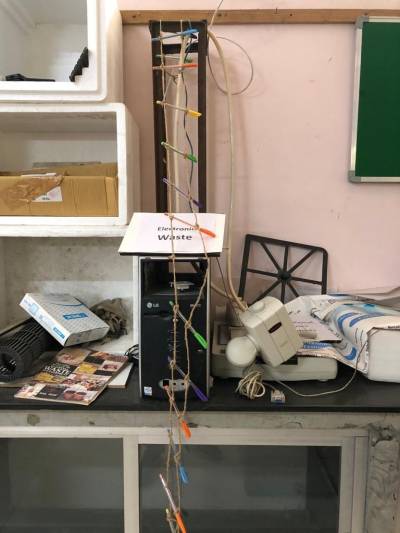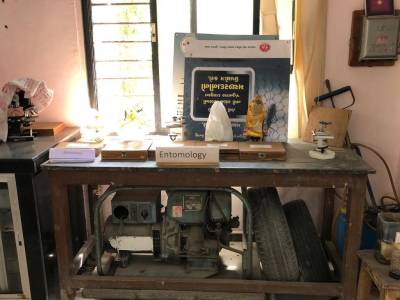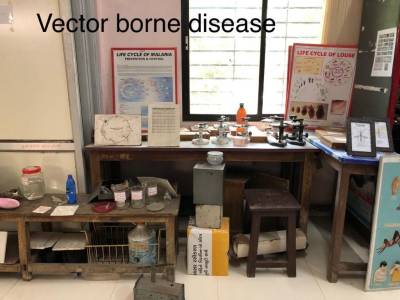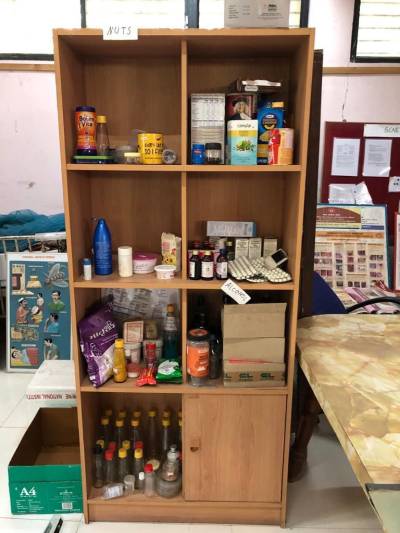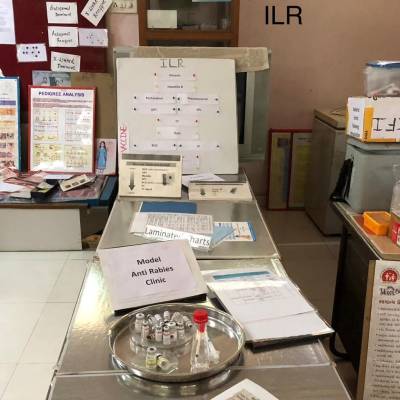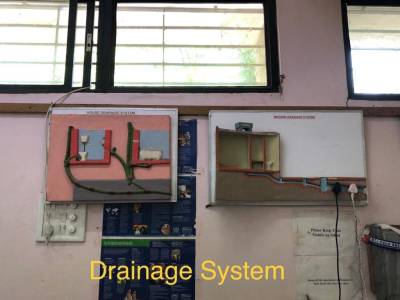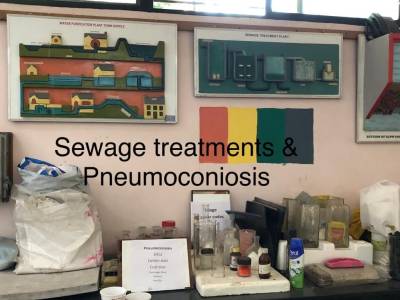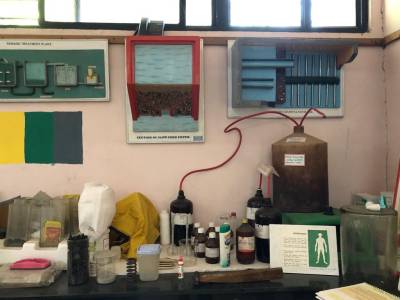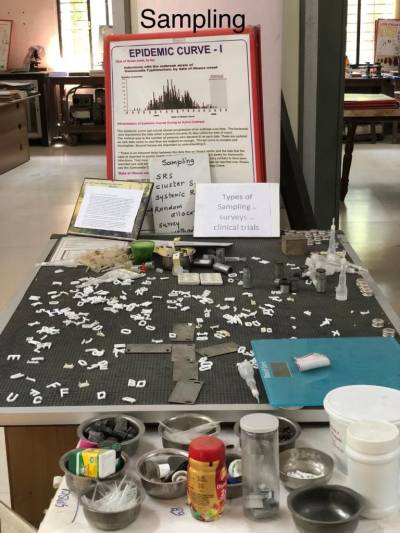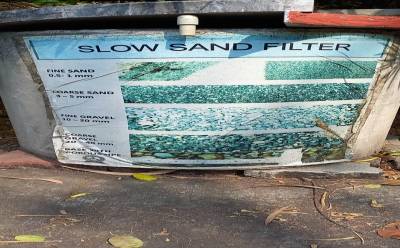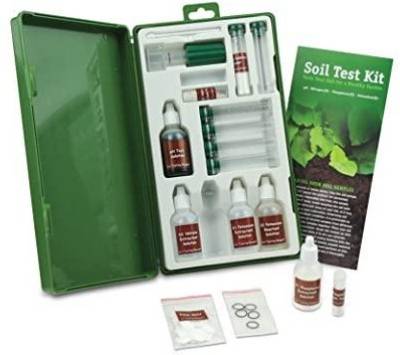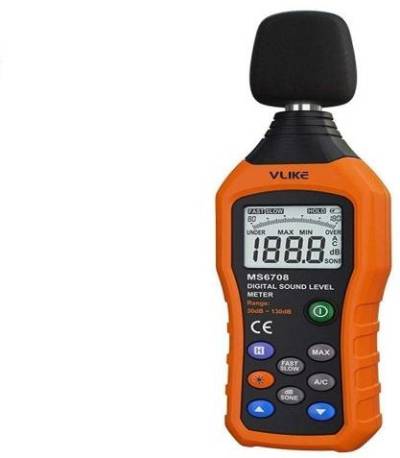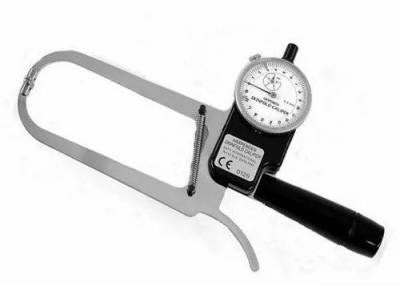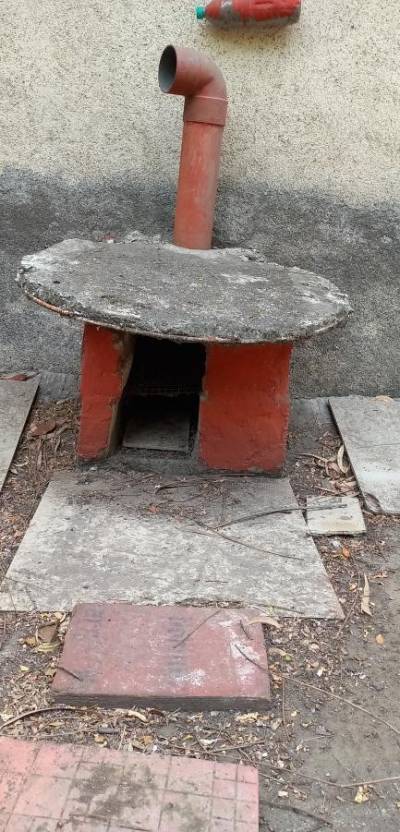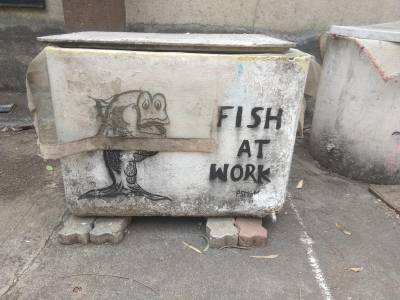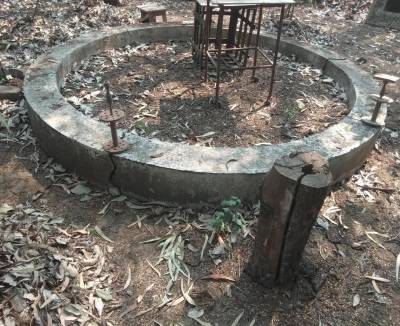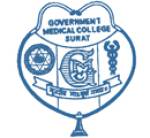 |  |  |
<html><center><font color=“white” size=“+4”>Department of PSM </font> </center></html>
Goal/Objectives
- GOAL:
The broad goal of the teaching of undergraduate students in Preventive & Social Medicine (Community Medicine) is to prepare them to function as community and first level physicians in accordance with the institutional goals, and to prepare them as teachers of PSM and Epidemiologists and public health consultants.
- OBJECTIVES :
(a) KNOWLEDGE :
At the end of the course, the student shall be able to :
- Describe the health care delivery system including rehabilitation of the disabled in the country.
- Describe the National Health Programmes with particular emphasis on maternal and child health programs, family welfare planning and population control.
- List epidemiological methods and describe their application to communicable and non-communicable diseases in the community or hospital situation.
- Apply bio-statistical methods and techniques.
- Outline the demographic pattern of the country and appreciate the roles of the individual, family, community and socio-cultural factors including urbanization on health and disease.
- Describe the health information systems.
- Enunciate the principles and components of primary health care and the national health policies to achieve the goal of Health for All.
- Identify the social environmental and occupational hazards and their control.
- Describe the importance of water and sanitation in human health.
- To understand the principles of Health Economics, Health Administration, Health Education in relation to community.
- Explain the principles of sociology including demography and population dynamics.
(b)SKILLS :
At the end of the course, the student should be able to:
- Use epidemiology as a scientific tool to make rational decisions relevant to community and individual patient intervention.
- Collect, analyze, interpret and present simple community and hospital based data.
- Diagnose and manage common health problems and emergencies at the individual, family and community levels keeping in mind the existing health care resources and in the context of the prevailing socio-cultural beliefs.
- Diagnose and manage maternal and child health problems and advise a couple and the community on the family welfare planning methods available in the context of the national priorities.
- Diagnose and manage common nutritional problems at the individual and community level.
- Acquire managerial skills of a health professional manager.
- Plan, Implement and evaluate a health education programme with skill to use simple audio-visual aids.
- Interact with other members of the health care team and participate in the organization of health care services and implementation of national health programmes.
- Conduct a survey and employ its findings as measure towards arriving at a community diagnosis or to judge efficacy of a program
Faculty Members
Documents
| laboratory_document_1_.pdf | laboratory document |
| museum_psm_department_1_.pdf | museum department |
| pg_time_table.pdf | pg time table |
| slo_and_lesson_plans_psm_department.pdf | slo and lesson plans |
| fap_logbook.pdf | Fap logbook |
| log_book_psm.pdf | log book |
| spots_for_practical_learning.pdf | spots for practical learning |
Md Psm Lockbook
UHTC and RHTC Documents
FAP Family Adopation Programe
CURRICULUM :
1.Introduction to Humanities and Community Medicine : History of Medicine, Definition of Health, Concept of Health, Spectrum of Health, Determinants of Health, Indicators of Health.
2.Demography & Population Dynamics : Definition, Collection of Demographic Data, Populations Census, Records of Vital Statistics, Demographic Cycle, Demographic Trends in India, Definitions of Vital Events, Collection of Vital Statistics Data, Compilation, Tabulation and Presentation.
3.Health Economics : Introduction, Natural Economical resources of the Country, Economic Levels, Health Planning and Budgeting.
4.Social Science & Health :
(a)Medical Sociology : Concept and principles of Sociology, Social Sciences, Social Classification, Social Factors related to Health and Diseases, Social Organizations, Urban and rural Societies, Family Types, Functions and Role of Family in Health and Disease, Society and Culture, its Functions, Role of Culture in Health and Disease, Hospital Sociology.
(b)Behavioral Sciences : Community behavior and Ecology, Interaction of Human being to Human Environment, Social Psychology, Impact of Psychology on Health. Impact of Urbanization of Health and Disease, Medico-Social problems.
5.Hospital Management: Principles of practice of medicine including visit to the hospital for familiarization with elementary nursing practice, practices of sterilization, injection and dressing techniques, necessity for record keeping, art of communication with patients including history taking medico-social work and immunization against disease and health check-up.
6.Health Care Delivery System: Health care delivery system at Central, State, District and Local levels. Rural Health Services, Health Care of Community, Primary Health Care Comprehensive Health Care, Basic Health Care, Health Care Delivery, Health Status and Health Problems of India and Gujarat.
Field Visit to Health Establishment:
Following health establishment have been considered for field visits in these establishments Health Intervention Programme are Operative. Total 15 visits will be planned. Each visit will cover two hours of demonstrations, participation etc.
- Urban Health centre
- Family Visit in the community
- Anganwadi Centre
- Immunization clinic
- Malaria Clinic (NMEP)
- Curative and preventive General Practice Clinic
- Family Welfare Planning and training Centre
- Post Partum Unit
- District TB Clinic
- STD Clinic
- Medical Record Section of Hospital
- Hospital setup – Visit to learn autoclaving, sterilization, incineration, organization etc.
1.Environment Health
- Air and ventilation : Atmospheric air - its composition, effects of of vitiated air, overcrowding. Indices of thermal comfort, Natural and Artificial Ventilation. Air pollution, Air borne diseases, disinfection of air, Air conditioning, measurements of air temperature. Humidity and velocity. Indices of heat stress, effect of health on health.
- Lighting : Requirement, Sources, Measurements, Normal Standards, and Health effects of poor lighting.
- Noise : Sources, Properties, Measurements effects on human health, Noise control.
- Radiation : Sources, Type of radiation, Measurement, Effect on health, radiation protection and control.
- Housing in relation to health : Criteria for health housing , house standards over crowding, housing and health
- Disposal of Wastes: Collection, removal, Disposal of refuse, Night soil and sewage, Sanitary barrier, Fecal borne diseases various methods of disposal of dead.
- Village Sanitation : Housing, Provision of safe water supply, sanitary disposal of refuse and excreta, Village latrines, Manure pit.
- Sanitation of Camp and Fair : Site, Water supply, Control of food establishments, Disposal of refuse and excreta, Control of communicable diseases.
2.Nutrition and Health : Importance of safe milk and other food stuffs. Adulteration, Preservation food poisoning, food and milk borne disease. Role of nutrition in various diseases. Dietetics – nutritional surveys. National Nutritional Programmes.
3.Genetics and Health : Principles, Heredity chromosomal disorders and abnormalities, Population genetics, General Epidemiology and Control of genetic disorders, Genetic counseling.
4.General Epidemiology : Definition , Epidemiology methods, uses of Epidemiology, Screening of the disease, Epidemic investigation, infectious disease epidemiology, Disease transmission, Nature of reservoir of infection, immunity, immunoprophylaxis, National Immunization Programmes, Non –communicable epidemiology, Disease control and prevention, Health advise to travelers, Hospital acquired infection, Notification, Isolation, Quarantine, Surveillance, Disinfection and sterilization.
5.Systematic Epidemiology :
- Communicable diseases : Problem, Epidemiology, Prevention, Control and national Control and eradication programmes of Common Communicable disease such As small-pox, Chickenpox, Measles, Rubella, Mumps, Influenza, Diphtheria, Whooping Cough, Meningococcal meningitis, Viral hepatitis, Cholera, Enteric fever, Tuberculosis, Acute Respiratory Infections, Poliomyelitis, Food poisoning, Acute Respiratory Infections, Poliomyelitis, Food poisoning, Amoebiasis, Bacillary dysentery, Diarrheal diseases, Helminthes infestations, Guinea worm, Yellow fever, Dengue fever, KFD, Japanese encephalitis, Leptospirosis, Rabies, Trachoma, Tetanus, Leprosy, STD, AIDS, Yaws etc.
- Non- Communicable Diseases: Problem, Epidemiology, Prevention, Control and National Control Programmes of Common non- communicable diseases such as Cancer, Cardio- Vascular diseases, Rheumatic fever and heart disease, Hypertension, Diabetes, Obesity, Blindness, Accidents etc.
6.Occupational Health: Occupation environment, Interaction of Physical, Chemical, Biological, Mechanical and Social agents with man, Occupational hazards and diseases of importance and their prevention and control such as Pneumoconiosis, Lead poisoning, Occupational Cancers, Occupational dermatitis, Radiation hazards, Hazards of Agricultural workers, Accidents in Industry, Industrial Toxicology, Sickness Absenteeism, Health Problems and General measures of prevention and control of industrial problems, prevention and control of occupational diseases, Indian Factory Act and ESIS Act, Industrial Social Security.
7.Maternal and Child Health and Family Planning : Maternal and infant mortality and morbidity in the country, Causes and schemes for its prevention. Measures for promotion of maternal and child welfare. Prevention of pre-natal, Neonatal and infant deaths, Care of the pre-school child. Various National, State and Voluntary agencies for child and maternal protection, Socio- economic and educational aspects of the problem.
8. School Health: School premises and environmental sanitation, Periodic medical inspections. Early detection of aliments, Defects and their treatment. Correction of deformities, Mid-day meal programmes, Care of the backward Child, Health education.
9. Family Planning: Medico-Social and Health aspects of Family Planning, Contraceptives, National Family Welfare Programme, Post Partum Programme, Medical Termination of Pregnancy Act.
10. Geriatrics & Health: Problems of Aging, Health Status of aged persons, Measures to solve problems of aged persons
11.Mental Health: Mental Deficiency, Care and Control of Mental Health, Child Guidance Clinics, Drug dependence and its control
12.Health Education: Principles of Health Education, Health and personal Habits, Various Methods for dissemination of the knowledge.
13. Public Health Administration: Health planning, Health Management, Health Planning in India, Bhore Committee, Mudaliar Committee, Other Health Committee reports for Health Planning in India, Five Year Health Plans, Health for all by 2000 AD, Health Status and Health Problems of India & Gujarat. Resources like Health Manpower, Money, and Material etc. to improve Health Status of People, Hospitals, Health Insurance, and Governmental& Non- Governmental Health Agencies. National Health Programs of India, ROME, ICDS etc. International Health Organizations like WHO, UNICEF, FAO, ILO, CARE and others.
Field Visit/ Practicals/ Clinics/ Tutorials/ Demonstrations/ Community Posting/ etc : Following subjects will be covered through teaching methods using field visits, practical, Clinics, Tutorials, Demonstrations, Community Posting, Workshops, etc. Students will be posted for 4 weeks each during third, fourth and sixth semesters (Total posting period will be 12 weeks). If required additional periods of two hours each will be arranged depending upon subjects and suitable community hour exposure.
1.Training in Hospital :
- Hospital visit will be arranged to demonstrate following:
- Nursing including bed making.
- Techniques of disinfection and dressing.
- Management of hospital including Clean Linen.
- Bedside manners and Medical ethics.
- Art of communication, history taking, winning the confidence of the patient.
- Keeping- completeness and reliability.
- Patient’s psychology understanding the patient’s perception of his problem.
- Medico- Social Work.
- Principles of health education- Doctor’s Role.
2.Field Visits : Field Visits will be arranged to learn the following:
- Factors determining health and disease including environment influences.
- Applied Sociology – importance of community Participation.
- Limited resources – Necessity of maximization of utilization.
- Effect of nutrition on Health & Disease.
- Acute infectious diseases and other local endemic diseases, for example, trachoma, goiter, filariasis etc.
- Tuberculosis
- Preventive aspect of psychological medicine and psychiatry.
- Preventive aspects of Leprosy.
- V. D. Control.
- Preventive aspects of dietetics and Nutrition information on all National Health Organization.
Family Welfare Planning and Community Medicine:
- The need for Family Panning.
- Organization of Family Planning Services.
- Health Education in relation to family Planning.
- Nutrition.
- Psychological needs of the mother, the child and the family.
- Demography and vital statistics.
3.Health Information and Basic Medical statistics: Sources and presentation of data, Sampling, Measures of Central Tendency, Variability, Probability, Normal Distribution and Normal Curve, Sampling Variability and Significance, Demography and Vital Statistics, Life table etc.
4.Environment Health:
- Role of environment in health and disease.Components of environmental health and their impact on health and disease.
- Sources, Collection, Storage and Distribution of water impurities and their relation to health, Purification, importance of safe water supply. Collection and forwarding of sample of water, analysis of water, standards of purity, public swimming bath sanitation. National Water Sanitation Programme. Water Borne Diseases.
- Medical Entomology:
Life history, role in disease transmission and control of common vectors of medical importance such as mosquitoes, housefly, sand fly, tsetse fly, rat flea , bedbugs, ticks, mites, Cyclops etc.
- Rodent:
Role in disease transmission, habitat and control of common rodents of medical importance.
- Insecticides:
- Classification, resistance and toxicity.
- Demonstrations on insects, micro-organisms, parasites, insecticides, rodenticides, instrument, food stuffs, immunological substances etc.
5. Epidemiological Exercises and Statistical Exercises: Students will be trained for epidemiological and statistical exercises, field visit demonstrations etc.
6.Family health and Clinico-Social Study.
7.National Health Programmes and Epidemic Situations. 8.Visit to an Industry and Class room demonstrations on occupational health relevant to state.
9.Project Work: Candidate would be assigned a project to learn epidemiology and management on specific of Health and Disease subjects in community medicine. A report on it will be prepared and evaluate at the level of University examination.
CME and Workshops
| 10-04-2023 | Quiz on World Health Day on theme of “Health for All” | |
| 27-02-2023 | Adolescent Health Day Celebration | |
| 30-09-2022 | Anero Bal Melo | |
| 04-08-2022 | Breastfeeding Week Celebration | |
| 03-08-2022 | Workshop on Newer NMC Guidelines | |
| 17-06-2022 | A Panel Discussion on “Health Care needs of LGBTQAI Community” | |
| 04-06-2022 | World Environment Day Celebration | |
| 26-05-2022 | World Menstrual Hygiene Day Celebration |
Publications
| 1. | Priti S, Hitesh M, Rachana K, Sunil N. A Study on Perceptions and Knowledge of Current Public Health Situation of India among Future Mid-level Health Providers Studying at Program Study Center in South Gujarat, India. Ann Community Health 2020: 8(4):1-6 |
| 2. | Shah H, Solanki P, Kapadia R, Nayak. Mid-Level Health Providers- their perceptions and background knowledge pertaining to Comprehensive Primary Care (CPHC) and Health and Wellness Center (HWC)“. Healthline. 2020;11(2):40-47 |
| 3. | Verma M, Kosambiya JK. Plotting Kaplan–Meier curves for survival and time to HIV positivity among high-risk women: A cohort study. Indian J Community Med 2020;45:478-82 |
| 4. | Godbole NB, Moberg MS, Patel P, Kosambiya J, Salihu HM, Campos EA, Menezes L, Verma R, Wilson R. Paternal Involvement and Adverse Birth Outcomes in South Gujarat, India. International Journal of Maternal and Child Health and AIDS. 2020;9(1):161 |
| 5. | Samudyatha UC, Chaudhari V, Chauhan N, Damor R, Kosambiya JK, Munshi R. Restructuring the modified Faine's criteria for the diagnosis of leptospirosis in monsoon: A study from south Gujarat. Indian Journal of Community Medicine. 2020 Jan 1;45(1):36. |
| 6. | Surti S, Kosambiy2a JK, Patni M Mohamed F. Assessing the clinical and anthropological profile of HIV+ Adolescents in Surat, Gujarat: a cross-sectional study2020;11(2):48-52 |
| 7. | Manna S, Chauhan N T, Assessment of Obesity among Adolescents from an Urban Area of Western India. J Comprehensive Health 2020:8(1): 34-38 |
| 8. | Patel VC, Patel HB, Shah C. A study to know self-care practice among Diabetic Patients Residing at Urban Slum Area of Asrwa, Ahmedabad. Natl J Community Med 2020;11(7):299-303 |
| 9. | Grover D, Joseph J. The prevalence of internet addiction among school-going adolescents: A comparative assessment as per two screening criteria. J Mental Health Hum Behav 2020;25:133-7 |
| 10. | Samudyatha U, Chaudhari V, Chauhan N, Damor R, Kosambiya J, Munshi R. Restructuring the modified Faine’s criteria for the diagnosis of leptospirosis in monsoon: A study from south Gujarat. Indian J Community Med Off Publ Indian Assoc Prev Soc Med. 2020;45(1):36. |
| 11. | Gautham MS, Gururaj G, Varghese M, Benegal V, Rao GN, Kokane A, et al. The National Mental Health Survey of India (2016): Prevalence, socio-demographic correlates and treatment gap of mental morbidity. Int J Soc Psychiatry. 2020;66(4):361–72. |
| 12. | Arvind BA, Gururaj G, Rao GN, Pradeep BS, Mathew V, Benegal V, et al. Framework and approach for measuring performance and progress of mental health systems and services in India: National Mental Health Survey 2015–2016. Int J Ment Health Syst. 2020;14(1):1–11. |
| 13. | Buch RS, Moitra M, Damor R, Chauhan N. Decision-making skills: An assessment among adolescents in surat city. Indian J Community Med. 2021;46(2):195. |
| 14. | Pandit RJ, Ansari AI, Raval JN, Patel ZZ, Dixit RD, Shah PK, et al. Host Genetic Factors for COVID-19 Severity and Outcome in Western Indian Population [Internet]. Rochester, NY: Social Science Research Network; 2021 Feb [cited 2021 Dec 18]. Report No.: ID 3784796. Available from: https://papers.ssrn.com/abstract=3784796 |
| 15. | Divakar B, Patel R, Verma M. A cross-sectional study on pharmacovigilance among rural doctors and private practitioners. J Mahatma Gandhi Inst Med Sci 2021;26:46-51 |
| 16. | Samudyatha UC, Kosambiya JK, Patel HM. Cost-effectiveness of universal repeat human immunodeficiency virus screening in pregnancy: A cross-sectional study from Western India. Indian J Community Med 2021;46:668-72. |
| 17. | Engti R, Momin MH, Vyas SN. Social media addiction and its impact among the school students during COVID-19 lockdown in an urban area of western India: a cross sectional study. Int J Res Med Sci 2022;10:2870-7 |
| 18. | Patel G, Patel H, Modi A, Mukherjee A, Kosambiya JK. Birth Preparedness and Complication Readiness among Pregnant Women Attending an Urban Health Centre in Surat, India. Natl J Community Med 2022;13(11):803-808. DOI: 10.55489/njcm.131120222364 |
| 19. | Kosambiya JK, Vadgama P, Samudyatha UC, Rathod D, Buch R, Damor R. Active case finding of pulmonary tuberculosis and HIV infection among prisoners of South Gujarat: A cross sectional study. Indian J Tuberc. 2022 Apr;69(2):213-219. doi: 10.1016/j.ijtb.2021.08.001. Epub 2021 Aug 12. PMID: 35379404. |
| 20. | Samudyatha UC, Kosambiya JK, Rathore MS. HIV Care in the Times of COVID-19 Pandemic in Urban South Gujarat: An Operational Overview. J Int Assoc Provid AIDS Care. 2022;21:1–14. |
| 21. | Chauhan D, Verma S, Jadhav K, kumar K, Chauhan N, Kavishvar AB, Kosambiya JK. Diagnostic Accuracy of Rapid Antigen Test for COVID-19 Infection: A Retrospective Analysis. JouCli Diagnostic Res: 2022; 16(5):1-5 |
| 22. | Kosambiya JK (2022): Establishment of State Epidemic Intelligence Unit: From Thought to Action. Healthline. 2022; 13(1): 03-05. |
| 23. | Kosambiya JK, Desai VK, Pawar AB: Smart City Surat Alliance –Public health &Poshan Se Roshan, Medi Sscience, IMA Surat May 2022 P.17-19 |
| 24. | Rathore MS, Samudyatha UC, Kosambiya JK. Covid-19 Hazard Index: A Spatiotemporal Risk Forecast Tool.Natl J Community Med 2022;13(7):424-429. DOI: 10.55489/njcm.130720221346 |
| 25. | Mukherjee A., Chaudhari V, Patel G, Bodar K, Gupta A, Kosambiya JK. Parents’ Perception Towards Covid-19Vaccination for Children in Surat: A Cross Sectional Study. Natl J Community Med 2022.13(8):559-564 |
| 26. | Patel G, Modi A, Mukherjee A, Patel H, Kosambiya JK. “Assessment of husbhand’s awareness about Birth Preparedness and Complication Readiness (BPCR) in Surat City: A Cross Sectional Study”. IJMACR-May-June-2022,5(3):373-377 |
| 27. | Modi, A; Garcia- Alcaraz, C.; Trivedi, S.; Kosambiya J.K.; Wells, K.J. “I . . . Tell Her Not to Take Medicines”: Understanding Engagement in the Prevention of Mother to Child Transmission (PMTCT) Care Continuum through the Socio-Ecological Model. Int. J. Environ. res. Public Health 2022, 19,13530. |
| 28. | Patel VC, Patel N, Patel H. A community based study on prevalence and determinants of exclusive breastfeeding practice in an urban slum area of asrwa, Ahmedabad. International Journal of current Medical and pharmaceutical Research. 2022; 8(5A): 197-200 |
| 29. | Kosambiya JK, Vadgama P, Samudyatha UC, Rathod D, Buch R, Damor R. Active case finding of pulmonary tuberculosis and HIV infection among prisoners of South Gujarat: A cross sectional study. Indian J Tuberc. 2022 Apr;69(2):213-219. doi: 10.1016/j.ijtb.2021.08.001. Epub 2021 Aug 12. PMID: 35379404. |
| 30. | Inamdar SA, Kosambiya JK, Modi A. Caregiver's Burden of Children Living with HIV on Antiretroviral Therapy at an Urban Setup. Indian J Community Med. 2021 Oct-Dec;46(4):744-747. doi: 10.4103/ijcm.IJCM_49_21. Epub 2021 Dec 8. PMID: 35068748; PMCID: PMC8729272. |
| 31. | Pandit R, Singh I, Ansari A, Raval J, Patel Z, Dixit R, Shah P, Upadhyay K, Chauhan N, Desai K, Shah M, Modi B, Joshi M, Joshi C. First report on genome wide association study in western Indian population reveals host genetic factors for COVID-19 severity and outcome. Genomics. 2022 Jul;114(4):110399. doi: 10.1016/j.ygeno.2022.110399. Epub 2022 Jun 6. PMID: 35680011; PMCID: PMC9169419. |
| 32. | BuchRS, MoitraM, DamorR, ChauhanN. Decision making skills: Anassessment among adolescents in Suratcity.IndianJCommunityMed.2021;46(2):195,2022. |
| 33. | U C, Samudyatha & Kosambiya, Jayesh & Rathore, Manvendra. (2022). HIV Care in the Times of COVID-19 Pandemic in Urban South Gujarat: An Operational Overview. Journal of the International Association of Providers of AIDS Care (JIAPAC). 21. 1-14. |
| 34. | Dhwani N Chauhan, Shambhavi Verma, Kishor V Jadhav, M Kiran Kumar, Naresh T. Chauhan, Abhay B Kavishvar, Jayesh K Kosambiya (2022) Diagnostic Accuracy of Rapid Antigen Test for COVID-19 Infection: A Retrospective Analysis. Journal of Clinical and Diagnostic Research. Volume 16(5) p IC01-IC05. DOI: https://doi.org/10.7860/JCDR/2022/52529.16321. |
| 35. | Kosambiya JK (2022): Establishment of State Epidemic Intelligence Unit: From Thought to Action. Healthline. 2022; 13(1): 03-05. |
| 36. | Kosambiya JK, Desai VK, Pawar AB: Smart City Surat Alliance –Public health & Poshan Se Roshan, Medi Sscience, IMA Surat May 2022 P.17-19 |
| 37. | Rathore MS, Samudyatha UC, Kosambiya JK. Covid-19 Hazard Index: A Spatiotemporal Risk Forecast Tool.Natl J Community Med 2022;13(7):424-429. DOI: 10.55489/njcm.130720221346 |
| 38. | Mukherjee A, Chaudhari V, Patel G, Bodar K, Gupta A, Kosambiya JK. Parents’ Perception Towards Covid-19Vaccination for Children in Surat: A Cross Sectional Study. Natl J Community Med 2022;13(8):559-564. DOI: 10.55489/njcm.130820222039 |
| 39. | Kosambiya JK, Desai VK, Pawar AB: Tribal Health- Understanding to Act, Tribay Day 9th August. MediScience, IMA Surat September 2022 P. 17-19 |
| 40. | Geeta K Patel, Anjali Modi, Abhishek Mukerjee, Harshad Patel, J.K. Kosambiya, “Assessment of husband’s awareness about Birth Preparedness and Complication Readiness (BPCR) in Surat City: A Cross Sectional Study”, IJMACR-May- June-2022, Vol-5, issue-3, P.No.373-377. |
| 41. | Modi, A.; Garcia-Alcaraz, C.; Trivedi, S.; Kosambiya, J.K.; Wells,K. J. “I . . . Tell Her Not to Take Medicines”: Understanding Engagement in the Prevention of Mother to Child Transmission (PMTCT) Care Continuum through the Socio-Ecological Model. Int. J. Environ. Res. Public Health 2022, 19,13530. https://doi.org/10.3390/ijerph192013530 (20) (PDF) “I…Tell Her Not to Take Medicines”: Understanding Engagement in the Prevention of Mother to Child Transmission (PMTCT) Care Continuum through the Socio-Ecological Model. |
| 42. | Patel G, Patel H, Modi A, Mukherjee A, Kosambiya JK. Birth Preparedness and Complication Readiness Among Pregnant Women Attending an Urban Health Centre in Surat, India. Natl J Community Med 2022;13(11):803-808. DOI: 10.55489/njcm.131120222364 |
| 43. | Verma M, Kosambiya JK, Divakar B. Forecasting HIV positivity through identification of predictors amongst high riskwomen: A cohort study. J Family Med Prim Care 2022;11:7756 62 |
| 44. | Samudyatha UC, Kosambiya JK, Madhukumar S. Community medicine in Ayushman Bharat digital mission: The hidden cornerstone. Indian J Community Med 2023; 48:326 33. |
| 45. | Kavita Bodar, Raktim Engti, Vipul Chaudhari, J.K. Kosambiya. knowledge of handwashing among the medical and nursing professionals of atertiary care teaching hospital in south gujarat, india after covid – 19pandemic: a cross-sectional study . International Journal of Advance Research 2023,11(02):902-907 |
Laboratory
Cupboard-1
| Serial No. | Item name | Pieces |
| Rack-1 | ||
| 1. | Slide Box | 13 |
| 2. | Test Tube Box | 2 |
| Rack-2 | ||
| 3. | Small Funnel | 14 |
| 4. | Big Funnel | 7 |
| 5. | Petri Dish | 35 |
| 6. | Beaker (50 ml) | 3 |
| 7. | Beaker (100 ml) | 1 |
| 8. | Test Tube (100 ml) | 4 |
| 9. | Test Tube (10 ml) | 9 |
| 10. | Measuring Cylinder (50 ml) | 6 |
| 11. | Flask (50 ml) | 5 |
| 12. | Plastic Funnel | 1 |
| 13. | Test tube box | 1 |
| Rack-3 | ||
| 14. | Test Tube Box (Small) | 2 |
| 15. | Test Tube Box (Big) | 1 |
| 16. | Cover Slip Box | 2 |
| 17. | Tray with Miscellaneous Items | 1 |
| 18. | Chloroscope Box | 15 |
| 19. | Magnetic Stirrer | 1 |
| Rack-4 | ||
| 20. | Burette (25 ml) | 5 |
| 21. | Magnifying Glass | 2 |
| 22. | Unidentified Thing | 2 |
| 23. | Flask (250 ml) | 5 |
| 24. | Test Tube (50 ml) | 24 |
| 25. | Round Bottom Flask (500 ml) | 1 |
| 26. | Silicon Bowl | 5 |
| Rack-5 | ||
| 27. | Measuring Cylinder (250 ml) (Borosil) | 5 |
| 28. | Measuring Cylinder (250 ml) (Plastic) | 1 |
| 29. | Measuring Cylinder (500 ml) | 7 |
| 30. | Measuring Cylinder (1000 ml) | 5 |
| 31. | Measuring Cylinder (100 ml) | 1 |
| 32. | Measuring Cylinder (50 ml) | 2 |
| 33. | Measuring Cylinder (25 ml) | 4 |
| 34. | Test Tube (100 ml) | 4 |
| 35. | Beaker (2000 ml) | 3 |
| 36. | Beaker (100 ml) | 3 |
| 37. | Flask (1000 ml) | 5 |
| 38. | Flask (500 ml) | 10 |
| 39. | Round Bottom Flask (1000 ml) | 2 |
| 40. | Round Bottom Flask (2000 ml) | 1 |
| 41. | Round Bottom Flask with Nozzle (500 ml) | 2 |
| 42. | Unidentified Things | 1 |
Cupboard-2
| Sr. No. | Item name | Pieces |
| 1. | Dissecting Microscope | 32 |
Cupboard-3
| Serial No. | Item name | Pieces |
| Rack-1 | ||
| 1. | Test tube box | 1 |
| 2. | Jar box | 1 |
| Rack-2 | ||
| 3. | Glassware tray | 2 |
Books
| Serial No. | Name of book | No. of pieces |
| 1 | Pathology laboratory report form book | 8 |
| 2 | Biochemistry request form book | 1 |
| 3 | Microbiology laboratory report form book | 1 |
| 4 | Pathology laboratory register | 3 |
| 5 | Primary Health Center laboratory Manual | 1 |
| 6 | Community Health Center laboratory Manual | 1 |
| 7 | Microscope (Labo Med) User Manual | 2 |
| 8 | Prevention and Control of Fluorosis in India | 1 |
| 9 | Water quality & Defluoridation technique | 1 |
| 10 | Laboratory Manual | 1 |
| 11 | Manual for monitoring of Iodine Deficiency Disorders | 1 |
| 12 | Basic Malaria Microscopy | 1 |
Stations
| Serial No. | Name of station |
| 1 | Microscopy |
| 2 | Estimation of Chlorine demand from drinking water |
| 3 | Determination of Chlorine |
| 4 | Estimation of Iodine and Fluoride in water using Ion specific electrodes |
| 5 | Entomology and Vector bionomics |
| 6 | Salt-sugar solution |
| 7 | Salt Testing for Iodine |
| 8 | Screening for cervical cancer |
| 9 | Estimation of available calcium & Magnesium in soil |
| 10 | ZN staining & Malaria staining |
| 11 | Standards of drinking water quality |
| 12 | Instruments-Incubator, Water bath, Magnetic stirrer, Illuminator |
Station 1: Microscopy PSMP and AFB
| SLO: At the end of session, student should be able to |
| 1. | Prepare blood smear to identify malarial parasite. |
| 2. | Identify malaria parasite and identify p. vivax and p. falciparum. |
| 3. | Prepare sputum smear and examine it. |
| 4. | Identify Acid fast bacilli on smear. |
| Materials used: Microscope, slides, samples, needles, cotton, containers etc. |
|---|
Method of teaching: Demonstration, Discussion on identifying the differential features of p.vivax and p. falciparum, Discussion on identifying the AFB on smear, fine and coarse adjustment
| Method of assessment: viva questions, |
|---|
| Questions: |
|---|
| 1. | How do you prepare blood smear on slide? |
| 2. | What are the differentiating features of p. vivax and p. falciparum |
| 3. | What are the physical characteristic features of Acid fast bacilli |
Station 2: Estimation of chlorine demand in water
| SLO: At the end of session, student should be able to |
| 1. | Know use of Horrock’s Apparatus |
| 2. | Estimate the dose of bleaching powder to disinfect the water. |
| 3. | Demonstrate the procedure of estimation of Chlorine demand of drinking water sample. |
| Materials used: Horrock’s apparatus, Water sample |
|---|
Method of teaching: Demonstration, Explaining the procedure of staining, Discussion on identifying the differential features of p.vivax and p. falciparum, Discussion on identifying the AFB on smear
| Method of assessment: Viva questions, short questions Questions |
|---|
| Questions: |
|---|
| 1. | What is the interpretation of the test? |
| 2. | What is the value of free residual chlorine? |
| 3. | How can you estimate the chlorine demand of drinking water? |
Station 3: Check residual chlorine in chlorinated water sample
| SLO: At the end of session, student should be able to |
| 1. | Know different method of chlorination. |
| 2. | Know the use of Chloroscope. |
| 3. | Define and explain the break point chlorination, super chlorination, chlorine demand and free residual chlorine. |
| 4. | Know the value of free residual chlorine. |
| Materials used: Chloroscope |
|---|
Method of teaching: Demonstration, Explaining the procedure of staining, Discussion on identifying the differential features of p.vivax and p. falciparum, Discussion on identifying the AFB on smear
| Method of assessment: Viva questions, short questions, short notes |
|---|
| Questions: |
|---|
| 1. | Define break point chlorination and free residual chlorine. |
| 2. | What is the value of free residual clorine? |
| 3. | How can you estimate the chlorine demand of drinking water? |
| 4. | What is the interpretation of the test? |
Station 4: Estimation of Iodine and Fluorine in water
| SLO: At the end of session, student should be able to |
| 1. | Know normal value range of Iodine and Fluorine in water |
| 2. | Enumerate the diseases caused by deficiency and excess of Iodine and fluorine. |
| 3. | Able to perform testing of Iodine and Fluorine in water sample. |
| Materials used: Iodine and Fluorine Testing kit, fluoride electrode, pH meter |
|---|
| Method of teaching: Demonstration |
|---|
| Method of assessment: Viva questions, short questions, observing the procedure |
|---|
| Questions: |
|---|
| 1. | What is the normal value of Iodine and fluorine in drinking water? |
| 2. | Which diseases are caused by deficiency of Iodine? |
| 3. | Explain- ‘Fluorine-Double edged sword’ |
Station 5: Entomology and vector bionomics
| SLO: At the end of session, student should be able to |
| 1. | Identify different vectors and their species |
| 2. | Know diseases transmitted by different vectors |
| 3. | Understand the vectors interaction with the environment |
| Materials required: slides of mosquitos, housefly, sandfly, tick, mite and flea, magnifying class. |
|---|
| Method of teaching: Demonstration, discussion |
|---|
| Method of assessment: Viva questions, short questions |
|---|
^Questions:^
| 1. | Identify different vectors of medical importance |
| 2. | Which diseases are transmitted by rat flea/any vector? |
| 3. | How can we control rat flea/ any vector? |
Station 6: Home Made ORS
| SLO: At the end of session, student should be able to |
| 1. | Know use of Home Made ORS |
| 2. | Prepare home Made ORS |
| Materials used: Sugar, salt, clean drinking water, spoon |
|---|
^Method of teaching: Demonstration, explanation^
| Method of assessment: Viva questions, short questions, demonstration |
|---|
| Questions: |
|---|
| 1. | What is the composition of Home Made ORS? |
| 2. | What is the composition of WHO low Osmolarity ORS? |
| 3. | What are the indications of use of Home Made ORS? |
Station 8: Screening for Cervical Cancer
| SLO: At the end of session, student should be able to |
| 1. | Know the method of cervical Cancer screening |
| 2. | Able to identify pathology by using microscope |
| 3. | Know the epidemiology of Carcinoma Cervix |
| 4. | Know the preventive measures for Ca. Cervix. |
| Materials used: Prepared slide, binocular microscope |
|---|
| Method of teaching: Demonstration, explanation |
|---|
| Method of assessment: Viva questions, short questions, demonstration |
|---|
| Questions: |
|---|
| 1. | Which method is commonly used to screen Cervical Cancer? |
| 2. | Give identification features of Carcinoma on slides. |
| 3. | What is the causative organism for Carcinoma Cervix? |
| 4. | Which vaccines are available for Ca. Cervix? |
Station 9: Estimation of available Calcium and Magnesium in soil
| SLO: At the end of session, student should be able to |
| 1. | Know how to perform the test to check quantity of salts |
| 2. | Know the public health importance of Calcium and magnesium. |
| Materials used: Soil sample, soil testing kit |
|---|
| Method of teaching: Demonstration, Discussion |
|---|
| Method of assessment: viva questions, short questions, observing the procedure |
|---|
| Questions: |
|---|
| 1. | How will you check the quantity of available Calcium and Magnesium in soil? |
| 2. | How will you use soil testing kit? |
| 3. | What is the public health importance of Calcium and Magnesium? |
Station 10: Malaria stain and ZN stain
| SLO: At the end of session, student should be able to |
| 1. | Prepare blood smear to identify malarial parasite. |
| 2. | Prepare sputum smear to identify acid fast bacilli. |
| 3. | Demonstrate malaria staining and ZN stain |
| 4. | Know the use of stain and reagents. |
| Materials used: Slides, stains, reagents, samples, needles, cotton, containers etc. |
|---|
| Method of teaching: Demonstration, Explaining the procedure of staining |
|---|
| Method of assessment: viva questions, short questions, observing the procedure |
|---|
| Questions: |
|---|
| 1. | Which stains are used to stain malaria parasite and Acid Fast bacilli? |
| 2. | How will you stain the slide for blood and sputum sample? |
| 3. | What are the mechanism of above reagents and stains? |
Station 11: Checking standards of drinking water quality
| SLO: At the end of session, student should be able to |
| 1. | Know the WHO criteria for drinking water quality |
| 2. | Describe acceptability, microbiological, chemical and radiological aspects |
| 3. | Describe in detail chemical aspects of drinking water quality |
| 4. | Perform the test to quantify major minerals in water |
| Materials used: Water testing quality, water filters, water sample |
|---|
| Method of teaching: Demonstration, Explaining the procedure of testin discussion Method of assessment: viva questions, short questions, observing the procedure |
|---|
| Questions: |
|---|
| 1. | What is the WHO criteria for drinking water quality? |
| 2. | How will you check quantity of minerals in drinking water? |
| 3. | Describe chemical aspects of drinking water. |
Station 12: Incubator
| SLO: At the end of session, student should be able to |
| 1. | Know the mechanism of incubator and water bath. |
| 2. | Know the procedure of incubation. |
| 3. | Which samples or chemical can be incubated. |
| Materials used: Incubator, water bath, magnetic stirrer, illuminator |
|---|
| Method of teaching: Demonstration, Explaining the procedure of incubator, discussion |
|---|
| Method of assessment: viva questions, short questions, short note, observing the procedure |
|---|
| Questions: |
|---|
| 1. | What is the principal and mechanism of incubator? |
| 2. | What is the procedure of incubation? |
Museum
Preface
The subject of Community Medicine also referred as Preventive & Social Medicine (P & SM) is learnt by multiple ways such as lectures, tutorials, practical, group discussion, field visits, family studies etc. The museum has been established in the Community Medicine Department in accordance with MCI guidelines and with an aim to make the medical students understand the various aspects of Public Health and its sub specialties. Entire museum has different segments. These different segments have been adequately covered by two and three dimensional models, charts, equipment, specimens. I am sure that the visits by the students as planned in the academic timetable and otherwise will be useful to them in acquiring the deep knowledge and understanding of this subject. The development of museum has been possible only due to the meticulous efforts of the faculty members and other staff members of this department. I would thank one and all staff members including teaching and non-teaching staff in this endeavor.
| Dr. Jayesh Kosambiya |
| Professor & Head |
| Community Medicine Department |
| Government Medical College, Surat |
| Sr.No. | Sections | Page No. |
| a) | List of charts | 5 |
| Infectious disease | ||
| Entomology | ||
| Nutrition | ||
| Immunization | ||
| Contraception | ||
| Epidemiology | ||
| Wooden charts | ||
| Pedigree charts | ||
| FIMNCI/IMNCI charts | ||
| New charts | ||
| b) | List of models | 11 |
| c) | List of specimens | 23 |
| Nutrition | ||
| Contraception | ||
| Reproductive and sexual health | ||
| Occupational | ||
| Environment | ||
| Immunization | ||
| Drugs | ||
| d) | List of Posters | 26 |
| e) | List of Stations | 27 |
| Station 1 Randomization and epidemiology charts | ||
| Station 2 Personal protective equipment’s | ||
| Station 3 Immunization & AEFI | ||
| Station 4 Contraception | ||
| Station 5 Newborn care | ||
| Station 6 Nutrition | ||
| Station 7 Oral rehydration therapy | ||
| Station 8 Growth and development | ||
| Station 9 bio-medical waste station | ||
| Station 10 Electric waste station | ||
| Station 11 Occupational injuries station | ||
| Station 12 Chlorination | ||
| Station 13 Entomology | ||
| f) | List of equipment’s – | 34 |
| Primary care (cupboard-3) | ||
| Primary care (cupboard-4) | ||
| equipment’s | ||
| g) | List of spots | 37 |
| h) | Annexure: photographs of museum | 43 |
| List of charts - 144 | ||
| List of specimens- 119 | ||
| List of equipment’s - 133 | ||
| List of models - 25 | ||
| List of posters - 15 |
a) LIST OF CHARTS -144
INFECTIOUS DISEASE:
| S. No | Details Of charts |
| 1. | Tuberculosis - mode of spread, control & prevention (i) |
| 2. | Tuberculosis - mode of spread, control & prevention (ii) |
| 3. | Polio - mode of spread, control & prevention |
| 4. | Diphtheria |
| 5. | Measles - mode of spread, control & prevention |
| 6. | Influenza |
| 7. | Acute respiratory infection - mode of spread, control & prevention |
| 8. | Rabies - mode of spread, control & prevention |
| 9. | Modes of disease transmission |
| 10. | Necator americanus and Ancylostoma duodenale |
| 11. | Ascariasis lumbericoides (Round worm) |
| 12. | Typhoid fever - mode of spread, control & prevention |
| 13. | Helminths protozoa infesting the human intestine |
| 14. | Acute diarrhoeal disease |
| 15. | Amoebiasis |
| 16. | Acute infectious diarrohea |
| 17. | Transmission of viruses that causes disease |
| 18. | Dengue syndrome |
| 19. | Leprosy |
ENTOMOLOGY:
| S. No | Details Of charts |
| 1. | Life cycle of mosquito |
| 2. | Life cycle of louse |
| 3. | Life cycle of housefly |
| 4. | Life cycle of malaria prevention & control |
NUTRITION:
| S. No | Details Of charts |
| 1. | Vitamins - function, source & deficiency (part-1) |
| 2. | Vitamins - function, source & deficiency (part-2) |
| 3. | Iodine deficiency disorders part-1 |
| 4. | Iodine deficiency disorders part-2 |
| 5. | Iodine deficiency disorders part-3 |
| 6. | Understanding type 1 diabetes |
| 7. | Understanding hypertension |
| 8. | Anemia |
| 9. | Vitamin 'a' deficiencies |
| 10. | Balance diets for children & adolescents |
| 11. | Balance diets for pre-school children |
| 12. | Keys to healthy eating |
| 13. | Recommended dietary allowances |
| 14. | Types of fluorosis |
| 15. | Calorie value of common foods |
| 16. | Daily diet for adult suffering from high blood pressure |
| 17. | Diets for diabetic male |
| 18. | Food values of principal Indian types of food and vegetables |
| 19. | Universal access to iodised salt |
| 20. | Iodine testing kit |
| 21. | Area of salt production/ status of ban notification |
| 22. | Janani suraksha yojana |
IMMUNIZATION:
| S. No | Details Of charts |
| 1. | Breastfeeding & human lactation (1) |
| 2. | Breastfeeding & human lactation (2) |
| 3. | Growth & development of infant (part 1) |
| 4. | Growth & development of infant (part 2) |
| 5. | Nutrition during pregnancy part - 1 |
| 6. | Nutrition during pregnancy part - 2 |
| 7. | Balance diets & recipes for normal pregnant & lactating women ( 1and 2) |
| 8. | Feeding schedule of preterm infants and thumb rule for growth |
| 9. | Normal height and weight table |
| 10. | Immunization schedule |
| 11. | Vaccination schedule |
| 12. | Growth chart |
CONTRACEPTION:
| S. No | Details Of charts |
| 1. | Contraceptive devices & techniques |
| 2. | Contraceptive devices & techniques part-1 |
| 3. | Contraceptive devices & techniques part-2 |
| 4. | Std (sexually transmitted disease) |
| 5. | Hormones oral contraceptives |
| 6. | Family planning method |
| 7. | 380-a copper-t |
EPIDEMIOLOGY:
| S. No | Details Of charts |
| 1. | Epidemic curve-1 |
| 2. | Epidemic curve-2 |
| 3. | Propagated epidemic |
| 4. | Normal distribution curve |
| 5. | Pedigree analysis |
| 6. | Hospital waste management |
| 7. | Hospital waste management |
| 8. | Occupational health chart |
WOODEN CHARTS:
| S. No | Details of charts |
| 1. | Case control study |
| 2. | Epidemiology concepts |
| 3. | Epidemiology curve |
| 4. | Relation between incidence and prevalence |
| 5. | Incubation period |
| 6. | Skewed distribution |
| 7. | Natural history of disease |
| 8. | Iceberg disease |
| 9. | Double pot method |
| 10. | Adult mosquito mouth part |
| 11. | RCT |
PEDIGREE CHARTS:
| Sr.No. | Name | Quantity | 1 | Pedigree analysis | 1 | |
| 2 | Examination of the new-born from head to toe for common birth defects | 1 | ||||
| 3 | Autosomal dominant | 1 | ||||
| 4 | Autosomal recessive | 1 | ||||
| 5 | X linked dominant | 1 | ||||
| 6 | X linked recessive | 1 | ||||
| 7 | Nuclear family demonstration chart | 1 | ||||
| 8 | Pedigree analysis (laminated charts) | 1 |
| 9 | Sickle cell booklet( Guajarati) | 1 |
| 10 | Down syndrome chart | 1 |
| 11 | Birth certificate (demo) | 1 |
FIMNCI/IMNCI CHARTS: 20
NEW CHARTS: 30
| Sr No. | TITLE |
| 1 | Phases of break- point chlorination |
| 2 | Environment |
| 3 | Five keys to safer food |
| 4 | Epidemiology- 1 |
| 5 | Epidemiology- 2 |
| 6 | Diabetes |
| 7 | Cold chain- 1 |
| 8 | Cold chain- 2 |
| 9 | Cold chain- 3 |
| 10 | National and International days related to Health |
| 11 | National history of communicable disease |
| 12 | National AIDS Control Program (NACO) evolution |
| 13 | Modified Case Definitions- 1 (Diarrhea, Acute Diarrheal Diseases…) |
| 14 | Modified Case Definitions- 2 (Dengue fever, DHF…) |
| 15 | Modified Case Definitions- 3 (Acute Encephalitis Syndrome, Meningitis…) |
| 16 | Modified Case Definitions- 4 (Fever of unknown origin, ARI…) |
| 17 | Comparison of Clinical trial phases |
| 18 | Census 2011 |
| 19 | Types of contraception |
| 20 | Component of National AIDS Control Program |
| 21 | Tasty tips for Smarter snacking |
| 22 | Natural history of Communicable disease (web of causation for myocardial infarction) |
| 23 | Epidemiological basis of HIV surveillance |
| 24 | Diagnostic algorithm for extra pulmonary TB |
| 25 | RO purification technology |
| 26 | RCH |
| 27 | Diagnostic algorithm for pulmonary TB |
| 28 | Diagnostic algorithm for pediatric Tuberculosis |
| 29 | What’s in the nutrition label |
| 30 | Balanced diet |
b)LIST OF MODELS -25
| Sr.No. | Models | Briefing |
| 1. | Slow Sand Filter | HISTORY: First used in Scotland (1804) and subsequently in England. |
| *Rate of filtration is 2-3 m.g.a.d | ||
| *Used for purification of water in small towns. | ||
| *Consists of four parts: Supernatant raw water, a bed of graded sand, an under-drainage system, a system of filter control valves. | ||
| *Works on principal of plain sedimentation. | ||
| *After use for first times, a slimy layer develops on the surface of the sand bed called as vital layer. The event is called “ripening of filter”. It removes organic matter, holds back bacteria and oxidizes ammoniacal nitrogen into nitrates and helps in yielding a bacteria free water. | ||
| *Effective size of sand 0.2-0.3 mm. | ||
| *Sand bed is cleaned by “scraping” off the top portion of sand layer to a depth of 1 or 2 cm. | ||
| *It removes bacteria by 99.9-99.0% | ||
| *It occupies a large area but it easily operated. | ||
| 2. | Rapid Sand Filter | *HISTORY:First used in USA (1885). |
| *Used for purification of water in big cities. | ||
| *Rapid sand filters are of two types: (1) Gravity type[Paterson’s Filter](2) Pressure type [Candy’s filter] | ||
| *Works on principal of coagulation and sedimentation. | ||
| *Steps involved in Rapid Sand Filter are: (1) Coagulation (2) Rapid Mixing (3) Flocculation (4) Sedimentation (5) Filtration | ||
| *Effective size of sand 0.4-0.7 mm. | ||
| *Here no vital layer is present, but the “alum-floc” not removed by sedimentation is held back on sand bed. This absorbs bacteria and effects purification and is comparable to vital layer in case of slow sand filter. | ||
| *Cleaning of sand bed is done by reversal of water flow causing dislodging of impurities. This is called “back- washing” | ||
| *It removes bacteria by 98-99% | ||
| *It occupies very little space, can deal with raw water directly but higher skills are required to operate it. | ||
| 3. | Chulha | *A kitchen stove, often made of earth or bricks stacked together in shape of cuboid with an opening for fuel at one side and open top for use. |
| *Fuels generally used are twigs, coal, dry wood. | ||
| *It is used in villages and also in urban slums. | ||
| *Indoor air quality is the quality of air within and around buildings and structures. | ||
| *It causes Indoor Air Pollution. | ||
| *It releases the harmful gases which causes respiratory problems like Asthma, bronchitis, COPD etc | ||
| *It emits a number of harmful gases including carbon monoxide which aided by improper ventilation and overcrowding causes a higher risk of Lung carcinoma | ||
| *People in villages believe that use of chulha makes the food pure and increases its nutrient value, because of this misbelief it has tough to eliminate this factor completely. | ||
| *Ujjwala Yojana of free cooking gas (LPG) for poor households has been implemented by Ministry of Petroleum and Natural Gas by Indian Government. |
| 4. | Autoclave | *Sterilizers which operate at high temperatures(in excess of 100 def C) and pressure are called autoclaves. |
| *Autoclave Sterilizers are used to decontaminate certain biological waste and sterilize media, instruments and lab ware. | ||
| *E.g. It is used for sterilization of contaminated waste, sharp waste, glassware. | ||
| *Regulated medical waste that might contain bacteria, viruses and other biological material are recommended to be inactivated by autoclaving before disposal. | ||
| *Principle: Steam under pressure-(saturated steam) which is most effective sterilizing agent. | ||
| *To be effective against spore forming bacteria and viruses, autoclaves need to have steam in direct contact with the material being sterilized (i.e. loading of items is very important). | ||
| *The efficiency of the sterilization process depends on two major factors. One of them is the thermal death time, i.e. the time microbes must be exposed to at a particular temperature before they are all dead. The second factor is the thermal death point or temperature at which all microbes in a sample are killed. | ||
| *Temperature- 121 deg C under 15 lbs /sq.inch | ||
| *Mode of Action Autoclave Sterilizers: | ||
| *Moist heat destroys microorganisms by the irreversible coagulation and denaturation of enzymes and structural proteins. In support of this fact, it has been found that the presence of moisture significantly affects the coagulation temperature of proteins and the temperature at which microorganisms are destroyed. | ||
| *Uses-It is most effective method for sterilization of linen, dressings, gloves, syringes, certain instruments and culture media. | ||
| *It is not suitable for sterilization of plastics and sharp instruments. | ||
| *Efficacy of Autoclaving checked by stearothermophilus bacillus. |
| 5. | Sanitary Latrine | *It is non service type latrine. |
| *Criteria of sanitary latrine- | ||
| 1.Excreta should not contaminate the ground or surface water. | ||
| 2.Excreta should not pollute the soil | ||
| 3.Excreta should not be accessible to flies, rodents, animals (pigs, dogs, cattle, etc.) and other vehicles of transmission | ||
| 4.Excreta should not create a nuisance due to odour or unsightly appearance | ||
| *It has water seal trap which prevents access by flies | ||
| *Trap acts as a water seal barrier. It is a bent pipe, about 7.5cm (3 in.) in diameter and is connected with pan. It holds water and provides the necessary water seal. | ||
| *The water seal is the distance between the level of water in trap and the lowest point in concave upper surface of the trap. | ||
| *Different types of sanitary latrines-borehole latrine, dug well latrine, water seal latrine. |
| 6. | Salter Weighing Machine | *It is used for monitoring of growth of child at Anganwadi |
| *Used for children 1-5 years | ||
| *It is provided by UNICEF | ||
| *It records and monitors the growth of child at periphery centers | ||
| *The spring hanging scale (SALTER) is commonly used for taking weight of children 1-5years. | ||
| *It is provided by UNICEF. | ||
| *This scale can weigh up to 25 kg and is graduated by 0.1kg (100g) increments. | ||
| *Steps for taking the weight of a child using Salter Scale: | ||
| 1.Hook the scale to a tripod or a stick held horizontally by two people at eye level. | ||
| 2.Suspend the weighing pants from the lower hook of scale and readjust the scale to zero. | ||
| 3.Undress the child and place him/her in the weighing pants. | ||
| 4.Hook the pants to the scale. When child is settled and the weight reading is stable record the weight to the nearest 100gms. | ||
| 5.Make sure that nobody touches the pants or the scale during weighing. Ensure that the child hangs freely without holding onto anything. | ||
| 6.Read and announce value from the scale. The assistant should repeat value for verification and record it immediately. | ||
| *It is used for monitoring of growth of child at Anganwadi. | ||
| *It records and monitors the growth of child at periphery centers. | ||
| *Early detection of malnutrition at periphery centers like anganwadi is possible with this Salter weighing scale and early referral of children is possible. |
| 7. | Reverse Osmosis Water System | *It is used for purification of water at house and industries |
| *It produces treated water stream and relatively concentrated water stream | ||
| *Uses a semi permeable membrane to remove ions, molecules and larger particles from water | ||
| *In reverse osmosis, an applied pressure is used to overcome pressure, that is driven by chemical potential differences of the solvent. | ||
| *Reverse osmosis can remove many types of dissolved and suspended chemical species as well as biological ones (principally bacteria) from water, and is used in both industrial processes and the production of potable water. | ||
| *The result is that the solute is retained on the pressurized side of the membrane and the pure solvent is allowed to pass to the other side. | ||
| *Household RO units use a lot of water because they have low back pressure so they recover only 5 to 15% of water | ||
| *Drinking water purification steps involved following: | ||
| 1.sediment filter to trap particles, including rust and calcium carbonate | ||
| 2.a second sediment filter with smaller pores | ||
| 3.An activated carbon filter to trap organic chemicals and chlorine, which will attack and degrade a thin film composite membrane | ||
| 4.A reverse osmosis filter, which is a thin film composite membrane | ||
| 5.Optionally, a second carbon filter to capture those chemicals not removed by the reverse osmosis membrane | ||
| 6.An ultraviolet lamp for sterilizing any microbes that may escape filtering by the reverse osmosis membrane. |
| 8. | Infantometer | *It is used to measure the length of infant |
| *Adv - easily transportable and flexible, durable and low maintenance cost. | ||
| *To monitor the growth of an infant at periphery centres. | ||
| *It has one fixed end and other end can be adjusted to the baby’s foot area | ||
| *Check that the child lies straight along the board and does not change position. Shoulders should touch the board, and the spine should not be arched. Ask the mother to inform you if the child arches the back or moves out of position. | ||
| *Hold down the child’s legs with one hand and move the footboard with the other. Apply gentle pressure to the knees to straighten the legs as far as they can go without causing injury. | ||
| *While holding the knees, pull the footboard against the child’s feet. The soles of the feet should be flat against the footboard, toes pointing upwards. | ||
| *If the child bends the toes and prevents the footboard from touching the soles, scratch the soles slightly and slide in the footboard quickly when the child straightens the toes. | ||
| *Read the measurement and record the child’s length in centimetres. |
| 9. | Rat Trapper | *It is used to catch the rats |
| *Rat traps are usually set in an indoor location where there is a suspected infestation of rats. | ||
| *Rat traps are of lethal and non lethal type. | ||
| Types : 1. Rat cage trap - Non lethal It is metal cage box shaped device to catch the rats without killing them. When an animal enters the cage and moves toward the bait, the mechanism triggers and closes a door over the entry point. The animal is caught alive and without injury. | ||
| 2.Glue rat trap - Non lethal | ||
| 3.Victor electric rat trap - Lethal | ||
| 4.Spring rat trap - Lethal | ||
| 5.Bucket rat trap - Non lethal or Lethal | ||
| 6.Disposable rat trap – Non lethal | ||
| 7.Good nature A24 – Lethal (kill by CO2 powdered piston, self resetting) | ||
| *Food bait is put in the cage trap in rat cage trap. | ||
| *Rats spread the diseases like plague, leptospirosis, rat bite fever etc. |
| 10 | Anemia Detection Chart | *It is used to detect iron deficiency for general public. |
| *Person has to see in mirror and compare his color of tongue or oral mucosa with that of chart. | ||
| *Anemia can be due to iron deficiency due to worm infestation, chronic blood loss etc. | ||
| *RDA of iron is 30 mg. |
| 11 | Sand Filter Model | *Used as a step in the water treatment process of water purification. |
| # | Three main types: | |
| Rapid (gravity) sand filters | ||
| Upward flow sand filters | ||
| Slow sand filters | ||
| # | The first two require the use of flocculent chemicals to work effectively while slow sand filters can produce very high quality water with pathogens removal, taste, odour without the need for chemical aids. | |
| # | Use: water treatment plants, water purification in singular households as they use materials which are available for most people. |
| 12 | Water Testing Field Kit | *It is called horrock’s apparatus |
| *It is used to find out the dose of bleaching powder required for disinfection of water | ||
| #Contents- | ||
| a. | 6 white cups | |
| b. | 1 black cup | |
| c. | 2 metal spoons | |
| d. | 7 glass stirring rods | |
| e. | One special pipette | |
| f. | Two droppers | |
| g. | Indicator: starch iodide solution | |
| #Procedure: | ||
| *Take one level spoonful (2g) of bleaching powder in the black cup and make it into a thin paste with a little water. Add more water to the paste and make up the volume up to the circular mark with vigorous stirring. Allow to settle .This is the stock solution. | ||
| *Fill the 6 white cups with water to be tested, up to about a cm below the brim. | ||
| *With the special pipette provided add one drop of the stock solution to the 1 st cup, 2 drops to the 2 nd cup, 3 drops to the 3 rd cup, and so on Stir the water in each cup using a separate rod. | ||
| *Wait for half an hour for the action of chlorine. | ||
| *Add 3 drops of starch iodide indicator to each of the white cups and stir again. development of blue colour indicates the presence of free residual chlorine. | ||
| *Note the first cup which shows distinct blue colour. Supposing the 3 rd cup shows blue colour, then 3 level to disinfect 455 litres of water. |
| 13 | Breeding Places Of Mosquitoes | *Anopheles- fresh water or salt-water, vegetative or non-vegetative, shady or sunlight. Ground pools, small streams, irrigated lands, freshwater marshes, forest pools, and any other place with clean, slow- moving water. |
| *Aedes- artificial collections of water like in tires, barrels, plastic drums, jerricans, mud pots, flower pots, discarded sinks, buckets, plastic bowls, dustbins, polythene sheets, and discarded excavator pot, abandoned tyres, shells of coconut, AC trays etc. | ||
| *Culex- dirty, polluted water like in blocked drains, cesspits, rainwater barrels, catch basins, storm drains, and septic tanks are rich in organic material etc. | ||
| *Mansonia- ponds and lakes containing certain aquatic plants, especially the floating type like Pistia stratiotes and water hyacinth. |
| 14 | Prevention And Control Of Malaria | |
| *Environment control- is best approach for vector control | ||
| 1.Anti adult measures | ||
| *Residual spraying: use of insecticides like Malathion, parathion, fenitrothion sprays, DDT spray and insecticide treated bed nets. | ||
| *Space application: involves application of pesticides in the form of fog or mist using special equipment. | ||
| *Individual protection: repellents, bed nets, mosquito coils, screening of houses etc. | ||
| 1.Anti larval measures | ||
| *Larvicides: Oiling the collection of standing water or with paris green. | ||
| *Source reduction: drainage or filling, deepening or flushing, management of water level, changing salt content of water. | ||
| *Integrated control: Bioenvironmental+ personal protection measure. | ||
| *Biological control- use of parvovirus fishes like Gambusia affinis, Leister reticulates. | ||
| *Early diagnosis and treatment. |
| 15 | Spread Of Malaria | *by the bite of female anopheles mosquito |
| *Other less common modes- blood transfusion, organ transplant, congenital malaria, in drug addicts. | ||
| *Signs and symptoms- fever with chills, headache, shivering, sweating, malaise and muscle pains. |
| 16 | TB Mode Of Spread | *Mainly from droplet infection and droplet nuclei |
| *Annually average of 10-15 persons contract the infection from 1 infected person | ||
| *World TB Day- 24th march | ||
| *Probability of Transmission of M. tuberculosis is determined by immune status of exposed individual. | ||
| *Number of bacilli expelled by infected person in the air, proximity frequency and duration of exposure. | ||
| *Features associated with increased infectiousness : | ||
| 1.Cough, lasting longer than 2 weeks. | ||
| 2.Inadequate treatment (drug, duration). | ||
| 3.Respiratory tract disease, larynx (highly infectious). | ||
| 4.Cavitation seen on chest x-ray. | ||
| 5.M. tuberculosis positive culture. | ||
| *Environmental factors to enhance transmission: | ||
| 1.Small and enclosed spaces. | ||
| 2.Inadequate ventilation | ||
| 3.Air recirculation |
| 17 | Cholera Mode Of Spread | *Acute diarrheal disease, kills within hours if untreated |
| *Transmission via contaminated water and food. | ||
| *Cholera outbreak can be seasonal or sporadic. | ||
| *Cholera transmits due to inadequate access to clean water and sanitation facilities. | ||
| *At risk areas are peri urban slums, refugee camps. | ||
| *During disasters and crisis causing disruption of water supply and sanitation system leads to increased transmission of cholera. | ||
| *Prevention by surveillance, water and sanitation, hygiene, social mobilization. | ||
| *Cholera cases are detected based on clinical suspicion in patients who present with severe acute watery diarrhoea. | ||
| *The suspicion is then confirmed by identifying V. cholerae in stool samples from affected patients. | ||
| *Test- Rapid diagnostic test. | ||
| *It is a notifiable disease. | ||
| *Treatment – ORS therapy and antibiotics. | ||
| *Both an endemic and epidemic disease. |
| 18 | Hookworm | *Includes Ancyclostoma duodenale and Nector Americanus. |
| *Soil transmitted helminth (parasitic worm). | ||
| *Hookworms live in the small intestine. | ||
| *Hookworm eggs are passed in the feces of an infected person. | ||
| *When the infected person defecates outside (near bushes, in a garden, or field) or when the feces of an infected person are used as fertilizer, eggs are deposited on soil. They can then mature and hatch, releasing larvae (immature worms). | ||
| *Mode of transmission – The larvae mature and penetrate the skin of humans. | ||
| *Hookworm infection is mainly acquired by walking barefoot on contaminated soil. | ||
| *Symptoms: Mainly gastrointestinal symptoms. The most serious effects of hookworm infection are blood loss leading to anemia, in addition to protein loss. | ||
| *Reservoir- man | ||
| *Treatment- Albendazole, Mebendazole. + Iron Supplements. | ||
| *Diagnosis- by identifying hookworm eggs under microscope. | ||
| *Chandler’s index & gt;300 is important public. |
| 19 | Tracking bag | *It is a new innovation in India. |
| *It is a cloth bag, composed of fourteen pockets. | ||
| *It is one simple tool developed for follow up of beneficiaries through the filling of counterfoils from immunization cards. | ||
| *Twelve pockets in the bag indicate the months of the year. Counterfoils are filed into the pocket indicating the month when the next vaccine is due. | ||
| *The thirteenth pocket is used for counterfoils of beneficiaries who have left the area or died. | ||
| *The fourteenth pocket contains counterfoils of fully immunized children. | ||
| *Before the session, the health worker prepares a list of beneficiaries due on that day, based on the counterfoils in the pocket for that month. This list is then shared with the AWW or ASHA. As the children come for vaccination, their cards and counterfoils are updated, with the counterfoils moved to the pocket for the month when the next vaccination is due. | ||
| *At the end of each month, cars and counterfoils remaining behind represent drop outs to be followed up. | ||
due for vaccinations in next session.|
| 20 | Surat map | *Surat has population of 44.6 lacs. |
| *Tapi river flows through Surat. | ||
| *Literacy rate of Surat is 86.65% and sex ratio is 787/1000. | ||
| *Hazira port of Surat is used for trade purpose and Dumas beach is used for tourism. Surat is located in south part of Gujarat. | ||
| *Surat is the 2nd largest city in Gujarat. | ||
| *Surat has an area of 327km2 . | ||
| *Surat has 9 blocks: Kamrej, Mahuva, Umarpada, Palsana,Chorasi,Olpad, Bardoli, Mandavi and Mangrol. | ||
| *Surat corporation consists of 8 zones: East zone-A, East zone-B, West zone, Central zone, North zone, South zone, South east zone and South west zone. | ||
| *Government Medical College, Surat is located in South west zone of Surat municipality. |
| 21 | The Male Reproductive System | *The chart shows male reproductive system showing testis, epididymis, vas deferens, ejaculatory duct. |
| *By the 10th-12th week of Intra uterine life, genitalia start development and at 16 weeks post conception, the genitalia are formed and distinct. | ||
| *Androgenic effect in embryonic organs is mediated by Dihydro Testosterone (DHT) which is a product of testosterone after effected by 5 alpha reductase | ||
| *Testes descend into scrotal sac by sixth to 10th week, failure to which causes “Undescended Testes” | ||
| *Most boys begin puberty between the ages 9 to 14 characterized by growth spurts, facial hair, voice change etc. | ||
| *Permanent sterilization process for male is known as Vasectomy. | ||
| *Recently, Non-Scalpel Vasectomy is done under National Health Program. | ||
| *Vasectomy comprises of nicking the vas deferens, followed by folding and tying the ends. | ||
| *NSV as a male sterilization under project is funded by UNFPA. | ||
| *Proper hygiene, safe sex practices and improved knowledge,attitude and practice about male reproductive system can reduces rate of spread of various STDs like Gonorrhea, AIDS etc. |
| 22 | The Female Reproductive System | *The model shows female reproductive system including ovaries, fallopian tubes, uterus, vagina and vulva. |
| *In human the female reproductive system is immature at birth and develops to maturity at puberty to be able to produce gametes, and to carry a fetus to full term. | ||
| *Puberty usually occurs in girls between the ages 10 and 14 years. | ||
| *Fertilization usually occurs in the Fallopian tubes and marks the beginning of embryogenesis. | ||
| *Most women reach menopause between the ages of 45 and 55 years. | ||
| *Unintended pregnancy is a major women’s health problem. So, contraception is necessary. | ||
| *Barrier contraceptive devices like female condom, vaginal sponge, diaphragm is placed in vagina. | ||
| *It is important to have proper understanding of female reproductive system to maintain menstrual hygiene. | ||
| *Vaginitis is inflammation of the vagina and largely caused by infection. It is most common gynecological condition presented. |
| 23 | Application And Proper Placement Of Copper T | *The model shows cross section of female reproductive system. |
| Cu t 380a is used under national family welfare program. | ||
| Pregnancy rate for cut 380a is 0.5-0.8. | ||
| Timing of insertion-during menstruation or within 10 days of beginning of menstrual period, postpartum period, post puerperal insertion. |
| 24 | House Drainage System | *Septic tank is used for household sewage treatment. |
| Steps of purification- anaerobic digestion and aerobic oxidation. | ||
| Ideal retention period- 24 hours. | ||
| Desludging should be carried out once a year. |
| 25 | Modern Drainage System (Sewage Treatment Plant) | *Primary treatment: screening→ grit chamber→ primary sedimentation. |
| Secondary treatment: aerobic oxidation→ secondary sedimentation→ sludge digestion. |
c)List of Specimens -119
Nutrition:
| S. No | Specimen |
| 1. | Wheat |
| 2. | Rice |
| 3. | Maize |
| 4. | Jowar |
| 5. | Bajara |
| 6. | White gram( Kabuli chana ) |
| 7. | Cow peas( Chola ) |
| 8. | Black gram without covering |
| 9. | Bengal gram – whole |
| 10. | Bengal gram - Channa dal |
| 11. | Red gram |
| 12. | Green gram |
| 13. | Green gram whole |
| 14. | Phenugreek( Methi ) |
| 15. | Raagi |
| 16. | Milk powder |
| 17. | Iodized Salt |
| 18. | Salt testing kit |
| 19. | Balbhog |
| 20. | Balbhog candy |
| 21. | Folic Acid Tablets |
| 22. | Zinc Tablets |
| 23. | Ferrous acid syrup |
| 24. | Peanut |
| 25. | Cooking Oil |
| 26. | Vitamin A syrup |
| 27. | Vitamin A Capsules |
| 28. | Almond |
| 29. | Cashew nut |
| 30. | Soya bean |
| 31. | Egg |
| 32. | Curd |
| 33. | Jaggery |
| 34. | Cheese |
| 35. | Sabudana |
| 36. | Methelene Blue Solution |
Contraception:
| S. No | Specimen |
| 1. | Urine Pregnancy Test Kit (Nishchay) |
| 2. | Nirodh |
| 3. | Mala N tablets |
| 4. | Mala D tablets |
| 5. | Copper T with equipped devices |
| 6. | Mamta Card |
| 7. | Emergency Contraceptive Pill |
| 8. | Female Condom |
| 9. | Sims speculum |
| 10. | Anterior vaginal wall retractor |
| 11. | Chitteles forceps |
Reproductive and Sexual Health:
| S. No | Specimen |
| 1. | Syndromic Case Management of STI/RTI cases Kit 1 |
| 2. | Syndromic Case Management of STI/RTI cases Kit 2 |
| 3. | Syndromic Case Management of STI/RTI cases Kit 3 |
| 4. | Syndromic Case Management of STI/RTI cases Kit 4 |
| 5. | Syndromic Case Management of STI/RTI cases Kit 5 |
| 6. | Syndromic Case Management of STI/RTI cases Kit 6 |
| 7. | Syndromic Case Management of STI/RTI cases Kit 7 |
| 8. | Penis model |
| 9. | FDC Lamivudine+ Zidovudine |
| 10. | FDC Tenofovir + Lamivudine |
| 11. | FDC Abacavir + Lamivudine |
| 12. | FDC Lamivudine + Neverapine+ Zidovudine |
| 13. | FDC Zidovudine + Lamivudine |
| 14. | FDC Lopinavir + Ritonavir |
| 15. | FDC Efavirenz |
| 16. | FDC Efavirenz + Lamivudine + Tenofovir |
| 17. | FDC Atazanavir + Ritonavir |
| 18. | Tab Nevirapine |
Occupational:
| S. No | Specimen |
| 1. | Snellen`s Chart |
| 2. | Ischierra Chart |
| 3. | Road Traffic Accidents Photographs & Safety Measures |
| 4. | Ear muffs |
| 5. | Safety helmets |
| 6. | Gum boots |
| 7. | Dusk mask |
| 8. | Safety goggles |
| 9. | Latex hand gloves |
| 10. | Doctor gloves |
| 11. | Face mask |
| 12. | N95 respirator mask |
| 13. | Seat belt |
| 14. | Stones causing dust related occupational disease |
Environment:
| S. No | Specimen |
| 1. | Chloroscope kit |
| 2. | Horrock’s Apparatus |
| 3. | Chlorine tablets |
| 4. | Bleaching powder |
| 5. | Environmental thermometer |
| 6. | Vishwachem’s kit ( two in one apparatus for estimating Chlorine demand and assessing total residual chlorine) |
| 7. | Puro Water Filter |
| 8. | Autoclave |
| 9. | Wet and Dry Hygrometer |
| 10. | Maximum- Minimum Thermometer |
| 11. | Mercury Thermometer |
Immunization
| S. No | Specimen |
| 1. | OPV |
| 2. | Measles vaccine |
| 3. | IPV vaccine |
| 4. | BCG vaccine |
| 5. | Pentavalent vaccine |
| 6. | DPT vaccine |
| 7. | Hepatitis B vaccine |
| 8. | TT vaccine |
| 9. | ARV |
| 10. | 0.5 ml AD syringe |
| 11. | 0.1 ml Tuberculin syringe |
| 12. | Vaccine Carrier |
| 13. | Ice packs |
| 14. | Vitamin A syrup |
| 15. | Hub Cutter |
| 16. | Electronic Syringe destroyer |
| 17. | Vaccine tracker bag |
| 18. | Weighing scale |
| 19. | Hypodermic syringe |
| 20. | Hypodermic needle |
Drugs:
| 1. | Paracetamol Syrup |
| 2. | Co-trimoxazole Syrup |
| 3. | Anti -Leprosy Dugs |
| 4. | Gentian Violet |
| 5. | Anti -Retroviral Therapy |
| 6. | Anti-tubercular drugs (CAT-1 Old regimen) |
| 7. | Anti-tubercular drugs (CAT-2 Old regimen) |
| 8. | Anti-tubercular drugs (CAT-1 New regimen) |
| 9. | Anti-tubercular drugs (CAT-1 New regimen) |
d)List of Posters -15
| 1) | WHO Reference weight for length and weight for height (>87 cm) |
| 2) | WHO Reference weight for length and weight for height (<87 cm) |
| 3) | Management algorithm for treating acute asthma in a hospital |
| 4) | Volumes of starter formula per feed |
| 5) | Chart for Basic Life Support |
| 6) | Chart: Triage |
| 7) | Fluid requirement and feeding schedule in young infants |
| 8) | Flow chart for neonatal resuscitation. |
| 9) | Guidelines for initiation of phototherapy in neonatal hyperbilirubinemia. |
| 10) | Steps in the management of sick young infants and children admitted to hospital |
| 11) | Diets recommended in severe acute malnutrition |
| 12) | Management of severe acute malnutrition in hospital |
| 13) | Management of shock in a child with severe acute malnutrition |
| 14) | Checklist for young infant care T.A.B.C.F.M.F.M.C.F |
| 15) | Management of shock in child without severe acute malnutrition |
e)Stations kept at Museum-
Station 1 Survey methods, sampling design and randomization This model is made up of a number of sampling unit fitted or placed on a fixogram board having a large number of similar sized holes. This wooden board may be considered as sampling frame and the different objects kept n it become sampling units. This board may be taken as a village or a municipal ward or even a region or a country depending upon the need of explaining a number of survey methods, sampling techniques and calculation of probability. Homogenous or a heterogeneous localities or clusters may be demonstrated using this model and actual sampling of HHs may be carried out using random numbers and a specific sampling methods. This board or a sampling frame is so flexibly used that you may create additional land marks or may rapidly change the scenario for a multiphase sampling methods. The 15 filled containers attached to this model are the 15 clusters and these may be made homogenous or heterogeneous by shuffling the contents of these containers. In fact this board may be used for a variety of purposes like organizing vaccination sessions in an effective manner, conducting an active or a passive surveillance for any condition, conducting a case control study and demonstrating the schemes for recruitment of participants for CT or RCT. The same model may be conceptually used for showing a variety of barriers like topographical, geographical, linguistic and ethnic, cast and religious , socio economic and so on. I understand that all of above concepts can be shared virtually on ppt also and may be in a better manner but such a physical model may make teacher self-reliant while conducting such sessions. Similarly it may be a supplementary to the actual visit to the area for actually carrying out the task. I know that it is not easy to do or demonstrate whatever is written above bit this is one way of strengthening skill in epidemiology especially for post graduate education.
Station 1 Randomization and epidemiology charts
| Station 1 Randomization and epidemiology charts | No |
| Black board With Alphabets | 1 |
| Marbles | 20 |
| Iron plates | 5 |
| Ceramic plates | 4 |
| Small Wooden boxes | 10+ |
| Plastic tubes | 10+ |
| Charts of epidemic and its type | 1 |
| Charts of spot map | 1 |
| Epidemic Curve chart | 3 |
| Katori’s | 8 |
| Discarded empty IFA bottles | 20+ |
| Iron tray | 2 |
| Plastic caps | 10+ |
| Specimen board | 2 |
Station 2 Personal protective equipment’s
| Sr.no. | Name | Quantity |
| 1. | Gloves | 3 |
| 2. | Protective gowns | 2 |
| 3. | Head phones | 3 |
| 4. | Glasses | 4 |
| 5. | Masks | 4 |
| 6. | Head cover | 1 |
| 7. | Head gear | 1 |
| 8. | Face shield | 3 |
| 9. | N95 mask packets | 1 |
| 10. | PPE kit | 3 |
Station 3 IMMUNIZATION & AEFI
| Sr.No | Topic | Quantity |
| 1 | ILR(Ice-Lined Refrigerator | 1 |
| 2 | ILR information chart | 1 |
| 3 | Vaccine Carrier | 4 |
| 4 | Puncture proof container | 1 |
| 5 | Disposable syringes and needle 5cc , 2cc , 0.1 cc , Insulin syringe | 5 |
| 6 | Laminated chart- immunization schedule | 1 |
| 7 | IDSP Oct 2018 booklet | 1 |
| 8 | Deep freezer | |
| 9 | Immunization Schedule | 1 |
| 10 | Breast Feeding and human lactation I | 1 |
| 11 | Breast Feeding and human lactation II | 1 |
| 12 | Feeding schedule of pre-term infants & thumb rules for growth | 1 |
| 13 | Growth and development of infant birth to 1 year | 1 |
| 14 | Vaccine wheel | 10 |
| 15 | BCG | 5 |
| 16 | HEP B | 5 |
| 17 | OPV | 10 |
| 18 | PENTAVALENT | 5 |
| 19 | ROTA | 10 |
| 20 | MR | 10 |
| 21 | IPV | 5 |
| 22 | PNEUMOCOCCAL | 5 |
| 23 | DPT | 5 |
| 24 | TT | 5 |
| 25 | VITAMIN A | 5 |
| 26 | COVAXIN | 5 |
| 27 | COVISHEILD | 5 |
| 28 | ARV | 5 |
| 29 | AEFI Kit | 2 |
| 30 | Model anti rabies clinic | 1 |
Station 4 Contraception
| Serial No. | Objects Quantity | |
| 1 | Condom Vending Machine | 1 |
| 2 | Charts for STDs | 5 |
| 3 | Wooden model for female reproductive system | 1 |
| 4 | Wooden model for male reproductive system | 1 |
| 5 | Model for Natural Contraception | 2 |
| 6 | Wooden model for application and proper treatment for CU-T | |
| 7 | CU-T insertion instruments tray | 1 |
| 8 | CU-T | 70 |
| 9 | Jar with CU-T | 3 |
| 10 | Conventional OC Pills | 40 Packets |
| 11 | Progesterone only Pills | 2 Packets |
| 12 | Condom | 10 big Packets containing 100/Packet |
| 13 | Model for demonstration of condom use | 1 |
| 14 | Charts for family planning methods, contraceptive devices and techniques | 4 |
| 15 | Charts for STI management | 1 |
| 16 | Chart booklet on HIV/STI/RTI | 1 |
| 17 | Magazines on The Environmental Population Growth | 20 |
| 18 | Files and Magazines on Contraception | 2 |
| 19 | Pregnancy test kit box | 50 tests |
Station 5 Newborn Care
| Serial No. | Objects | Quantity |
| 1 | Weighing scale for newborn | 1 |
| 2 | Length scale for newborn | 1 |
| 3 | Radiant heat warmer | 1 |
| 4 | Oxygen humidifier | 1 |
| 5 | Steam inhaler | 1 |
| 6 | RT, Feeding tube | 2 |
| 7 | NS Pint | 1 |
| 8 | Newborn Delivery Pack (For Single use only) | 12 |
Station 6 Nutrition
| Sr.No | Name | Quantities |
| 1 | Pearl millet | 1 |
| 2 | Chana dal | 1 |
| 3 | Soya bean | 1 |
| 4 | Urad dal | 1 |
| 5 | Jowar | 1 |
| 6 | Wheat | 1 |
| 7 | Masoor dal | 1 |
| 8 | Fenugreek | 1 |
| 9 | Green gram | 1 |
| 10 | Black eyed peas | 1 |
| 11 | Rajma | 1 |
| 12 | Mat bean | 1 |
| 13 | Pigeon dal | 1 |
| 14 | Brown chickpeas | 1 |
| 15 | Fennel seeds | 1 |
| 16 | Tapioca pearls | 1 |
| 17 | Honey | 1 |
| 18 | Castor oil | 1 |
| 19 | Groundnut oil | 1 |
| 20 | Corn oil | 1 |
| 21 | Rice | 1 |
| 22 | Nankhatai | 1 |
| 23 | Cookies | 1 |
| 24 | Jaggery | 1 |
| 25 | Law calorie nutrition for people with diabetes | 1 |
| 26 | Water bottle | 1 |
Station 7 Oral Rehydration therapy
| Table: ORS | ||
| Sl.No | Items | Quantity |
| 1 | Aluminum vessel | 1 |
| 2 | Steel vessel | 1 |
| 3 | Plastic spoons | 6 |
| 4 | Steel lid | 1 |
| 5 | Chlorine tablets | 1 |
| 6 | Glass cup | 7 |
| 7 | Porcelain containers | 3 |
| 8 | Plastic jar | 1 |
| 9 | Plastic cup | 1 |
| 10 | Plastic water bottle | 2 |
| 11 | Steel spoon | 1 |
| 12 | Steel cup | 1 |
| 13 | Cardboard box containing ORS packets | 2 |
| 14 | Plastic box containing ORS packets | 1 |
| 15 | Glass containers of sugar and salt | 2 |
| 16 | Glass beaker | 1 |
Station 8 Growth and Development
| Sl No | Content | Quantity |
| 1 | A poster of Sankalith Bal Vikas Yojana | 1 |
| 2 | Growth chart | 3 |
| 3 | Kwashiorkor and Marasmus chart | 1 |
| 4 | Features of severe PEM | 1 |
| 5 | Making pregnancy and childbirth safe booklet | 15 |
| 6 | Breastfeed advice booklet | 30 |
| 7 | Death certificate | 5 |
| 8 | Birth certificate | 5 |
| 9 | Pedigree charts | 15 |
Station 9 Bio-medical waste Station
| Sr. No | Content | Quantity |
| 1 | Needle syringe destroyer | 1 |
| 2 | Autoclave | 1 |
| 3 | Yellow bin | 3 |
| 4 | Blue bin | 1 |
| 5 | Red bin | 1 |
| 6 | Vessel with petridish and instruments | 1 |
| 7 | White bottle for sharp discard | 1 |
| 8 | Small dish | 3 |
| 9 | Petri dish | 15 |
| 10 | Vinegar bottle | 1 |
| 11 | Tray | 1 |
| 12 | Thermocol tray | 1 |
| 13 | Model for deep burial | 1 |
| 14 | Bottle for inertization | 1 |
| 15 | Battery | 2 |
| 16 | Capacitor | 1 |
| 17 | Chart for hospital waste management | 2 |
| 18 | Bag | 1 |
| 19 | Oven | 1 |
| 20 | Box with 3 bulb | |
| 21 | Yellow Bag | 1 |
| 22 | Red Bag | 1 |
| 23 | Black bag | 1 |
Station 10 Electric Waste Station
| Sr.No | Content Quantity | |
| 1 | Thermocol Box | 13 |
| 2 | Keyboard | 1 |
| 3 | Remote | 1 |
| 4 | Filter | 1 |
| 5 | Electric wire | 1 |
| 6 | CPU | 1 |
| 7 | Phone charger | 1 |
| 8 | Model for occupational safety | 1 |
| 9 | Exhaust Fan | 1 |
| 10 | Mouse | 1 |
| 11 | Scanner | 1 |
| 12 | Metal Stand | 5 |
Station 11 Occupational Injuries Station
| Sr. No | Content Quantity | |
| 1 | Charts for occupational health | 6 |
| 2 | Model for air pollution | 1 |
Station 12 Chlorination
| Chlorination station | ||
| Sr.no | Name | Quantity |
| 1. | Slow sand filter | 1 |
| 2. | Rapid sand filter | 1 |
| 3. | Horrock’s box | 1 |
| 4. | Black bottle for chlorine tablets | 4 |
| 5. | Alum bottle | 1 |
| 6. | Chlorine tablets strips | 2 |
| 7. | Earthen pot with lid (6 litre) | 1 |
| 8. | Clay pot with lid and glass (13-15 litre) | 1 |
| 9. | Aqua purifier | 1 |
| 10. | Chlorine powder | 2 |
| 11. | Chloroscope | |
| 12. | Chlorine demand measuring appratus | 3 |
| 13. | Aluminium net | 1 |
| 14. | Plastic jug (10 litre) | 1 |
| 15. | Plastic jug (20 litre) | 1 |
| 16. | Chlorine liquid bottle | 2 |
| 17. | Washing hand chart | 1 |
Station 13 Entomology
| Entomology Station Table 1 | ||
| 1 | Slidebox Anopheles | 1 |
| 2 | Slidebox Culex | 1 |
| 3 | Slidebox Anopheles egg | 1 |
| 4 | Slidebox larvae | 1 |
| 5 | Microscope large | 1 |
| 6 | Microscope small | 5 |
| 7 | Diesel generating set | 1 |
| 8 | Tyres | 2 |
| 9 | Mosquito control measures poster | 2 |
| 10 | Residual spray | 1 |
| Table 2 | ||
| 1 | Specimen Temiphos | 3 |
| 2 | Specimen Municipal Dustin | 1 |
| 3 | Specimen Insecticide | 1 |
| 4 | Specimen Crude oil & Kerosene | 1 |
| 5 | Overhead tank | 1 |
| 6 | Dirty water | 1 |
| 7 | Coconut shells | 1 |
| 8 | Specimen large water body | 1 |
| 9 | Small tubes | 1 |
| 10 | Specimen edible oil | 1 |
| 11 | Specimen poison | 1 |
| 12 | Specimen Artificial collection of water | 1 |
| 13 | Open water for domestic use | 1 |
| 14 | Malaria IEC manual | 1 |
| Table 3 | ||
| 1 | Poster lifecycle of mosquito | 1 |
| 2 | Slidebox tick | 1 |
| 3 | Slidebox housefly pupae & larvae | 1 |
| 4 | Slidebox Culex eg g | 1 |
| 5 | Slidebox aedes adults | 1 |
| 6 | Slidebox Culex adult | 1 |
| 7 | Slidebox aedes eggs | 1 |
| 8 | Slidebox Sandfly | 1 |
| 9 | Slidebox lice | 1 |
| 10 | Slidebox bedbug | 1 |
| 11 | Slidebox Rat flea | 1 |
| 12 | Microscope | 9 |
f)List of equipment’s -133
Primary care (Cupboard-3)- equipment’s
| Sr. No | Object | Quantity |
| 1 | Soil Testing kit | 3 |
| 2 | Harpender Caliper | 6 |
| 3 | Digital Sound Meter | 4 |
| 4 | Electric Compact Scale | 1 |
| 5 | Spirometer | 1 |
| 6 | Telephone | 1 |
Primary care (Cupboard-4) - equipment’s
| Sr. No | Objects | Quantity |
| 1 | Exhaust Fan | 4 |
| 2 | Weighing Machine | 5 |
| 3 | Digital BP monitor | 2 |
| 4 | Haemometer | 6 |
| 5 | Chloroscope | 5 |
| 6 | Vaporizer | 1 |
| 7 | Calculator | 1 |
| 8 | Temperature recorder | 5 |
| 9 | Thermometer | 13 |
| 10 | Hygrometer | 4 |
| 11 | Hypodermic needle box | 7 |
| 12 | Hypodermic syringe box | 2 |
| 13 | Projector bulb | 1 |
| 14 | Spirit lamp | 1 |
| 15 | Dental instrument kit | 1 |
| 16 | Magnifying glass | 7 |
| 17 | Hematocytometer | 1 |
| 18 | Ink bottle | 1 |
| 19 | Glucometer | 1 |
| 20 | Syringe 10ml | 44 |
| 21 | Spirit bottle | 1 |
| 22 | Urine analysis kit | 1 |
| 23 | Face mask | 2 |
| 24 | Face shield | 1 |
| 25 | Dressing kit | 1 |
Equipment’s-
| 1 | Adult Weighing Scales (2 digital + 1 Mechanical) |
| 2 | Aqua Guard |
| 3 | Autoclave |
| 4 | Chemical Balance |
| 5 | Chloroscope with OT Solution |
| 6 | Cover slip boxes |
| 7 | Dissecting Microscopes |
| 8 | Hygrometer Wet & Dry Bulb (Hygrometer) |
| 9 | Maximum & Minimum Thermometer |
| 10 | Projector Screen |
| 11 | Slide boxes |
| 12 | Sling Psychrometer |
| 13 | Sphygmomanometer |
| 14 | Stethoscope |
| 15 | LCD Projectors |
| 16 | Overhead Projectors |
| 17 | White Board |
| 18 | Black Board |
| 19 | Desktop Computer system with Printer |
| 20 | Laptop |
| 21 | Domestic refrigerator |
| 22 | Horrock’s Apparatus (5) |
| 23 | Needle Shredder (3) |
| 24 | Dissecting microscope (30) |
| 25 | Water testing kit (at lab) |
| 26 | Sound level meter (5) |
| 27 | Clinical thermometer (15) |
| 28 | Barometer (1) |
| 29 | Herpenter Calliper (6) |
| 30 | Slide set for entomology (8) |
| 31 | Balance Analytical 200 gm(1) |
| 32 | Incubator electric (1) |
| 33 | Haemoglobinometer (8) |
| 34 | Glucometer (13) |
| 35 | Mosquito catching kit( 5) |
| 36 | Spirometer (1) |
| 37 | MUAC tap (15) |
| 38 | soil testing kit (2) |
| 39 | Pasteur chamber filter (1) |
g)List of spots in museum- 28
Spot 1.
| Q.1 | Mention a name of this food grain |
| Q.2 | Mention approximate value of calorie, protein and any one specific nutrient available from 100 grams of this food grain. |
| Q.3 |
Spot2.
| Q.1 | Mention a name of the nutrient for the supplementation of which this Medicine is prescribed |
| Q.2 | Mention approximate value of Recommended Daily Allowances of this specific nutrient for an adult healthy male |
| Q.3 | Mention any two clinical signs or symptoms which usually occurs due to deficiency of a nutrient mentioned above. |
Spot3
| Q.1 | Mention a name of this food item |
| Q.2 | Mention approximate value of calorie, protein and any one specific nutrient available from 100 grams of this food grain. |
| Q.3 | Mention any two clinical signs or symptoms which usually occurs due to deficiency of a nutrient you mentioned above. |
Spot4.
| Q.1 | Identify this photograph using maximum 4 words |
| Q.2 | List at least three epidemiological factors, one from each (agent, host and environment) which are associated with causation of condition depicted in this photograph |
| Q.3 | Give two action points for prevention and control of this condition. |
Spot5.
| Q.1 | Mention daily calorie requirement of a healthy adult non pregnant muslim woman , house wife having moderate activity , belonged to lower socioeconomic sector and staying at lane No 6, Rasulabad slum of Surat city. Her BMI is 27 and per capita income is 3000 rupees per month. |
| Q.2 | Describe one physical activity using 2 messages which can be recommended to her for prevention and control of obesity. |
| Q.3 | list two services which she can avail from government health centers under Non Communicable disease Control Program. |
Spot6
| Q.1 | Mention daily calorie requirement of a healthy but chronic alcoholic adult agricultural labor man, having heavy physical activity, holding valid BPL card and staying at halpati falia of Vanz village field practice area. His BMI is 22 and per capita income is 1000 rupees per month. |
| Q.2 | Describe one two health and wellness related messages which can be recommended to him for prevention and control of common diseases. |
| Q.3 | list two services which she can avail from government health centers under any government run welfare program. |
Spot7
| Q.1 | Write the contents of this Contraceptive |
| Q.2 | Give two important messages which are required to be passed to the beneficiary lady to whom it is advised. |
| Q.3 | Write the failure rate with its unit |
Spot8
| Q.1 | Write the name of this Contraceptive device |
| Q.2 | Give two important history points which must be ruled out before its insertion in the client which are required to be entered in the check list. |
| Q.3 | Write four common side effects of this device. |
Spot9
| Q.1 | Write the name of this Contraceptive method |
| Q.2 | Identify the time interval in which pregnancy would not take place even after sexual intercourse. |
| Q.3 | Write the failure rate with its unit |
Spot10
| Q.1 | Write name of the Pneumoconiosis caused by this dust/ dust producing substance |
| Q.2 | Name two industries where the cases of this condition occurs. |
| Q.3 | Write two preventive and control measures for this condition |
Spot11
| Q.1 | Identify this Personal Protective device |
| Q.2 | gave two names for industry/sites where it can be used |
| Q.3 | Name two occupational diseases which can be prevented by it. |
Spot12
| Q.1 | List any two contents of AEFI (Adverse Eventer Following Immunization) kit maintained at vaccination sessions |
| Q, 2 | Write names of two vaccines notorious for AEFI. |
| Q.3 | Relate any two contents of AEFI kit with two adverse effects for which these will be used. |
Spot13
| Q.1 | Classify this vaccine in to either Live or a Killed Vaccine. |
| Q, 2 | where will you keep it at PHC Vans village for maintaining Cold chain? |
| Q.3 | Mention its dose in a preterm baby having age of 6 weeks and weight of 3kg. |
Spot14
| Q.1 | In which colored bag/ container will you discard this Biomedical Waste item? |
| Q, 2 | Mention its category. |
| Q.3 | Mention its final treatment plans. |
Spot15
| Q.1 | How will you will you discard this this solid Waste item as per Gujarat Pollution control board norms? |
| Q, 2 | Mention its hazards to human health. |
| Q.3 | Mention its final treatment plans. |
Spot16
| Q.1 | Give a name for this type of chart. |
| Q.2 | Writer mode of inheritance . |
| Q.3 | Mention two diseases having this kind of mode of inheritance. |
Spot17
| Q.1 | Identify this insect. |
| Q. 2 | Mention two diseases transmitted by this insect. |
| Q.3 | Mention two measures to control diseases transmitted by this insect to humans. |
Spot18
| Q.1 | Write the composition of powder in this sachet having WHO formula |
| Q, 2 | |
| Q.3 | what will you do if a 4 year child having diarrhoea with moderate dehydration is not able to drink the solution prepared from this sachet/packet? |
Spot19
| Q.1 | Identify this device/equipment used in Occupational Health. |
| Q.2 | List two Pneumoconiosis for prevention of which this instrument is useful. |
| Q.3 | Write the mechanism by which it prevents or controls the above mentioned Pneumoconiosis |
Spot20
| Q.1 | Identify this instrument used by a Primary health care worker at village level |
| Q.2 | what is the expected free residual chlorine level at user end? Approximately How much chlorine level is kept at water works level in sutra in ordinary situations? |
| Q.3 | which solution is used to test measure free residual chlorine? How much amount of solution is dropped in a test tube to perform this test? |
Spot21
| Q.1 | Identify this dose of this medicine/syrup/tablet for a 5 year old child having the deficiency of same |
| Q.2 | List two clinical symptoms/signs related with above nutrient |
| Q.3 | Write the name of a national health program/ campaign related with the above nutrient. |
Spot22
| Q.1 | Identify this vector Control measure. |
| Q.2 | List two diseases which can be controlled using this measure. |
| Q.3 | Write the name of a national health program/ campaign related with the use of above measure. |
Spot23
| Q.1 | Identify the insect which can breed in such type of a breeding place. |
| Q.2 | List two diseases which can be transmitted by the above mentioned insect in humans. |
| Q.3 | Write two methods to control this insect breeding in such sites |
Spot24
| Q.1 | Identify the grade of Malnutrition by plotting weight for age on this chart: Age 18 months Weight: 8kg |
| Q.2 | List two actions to be taken at Primary Health center level for above child. |
| Q.3 | Write the name of a national health program/ scheme related with such a child. |
Spot25
| Q.1 | You are BHO of a block having population of one lakh with 150 eligible couples per 1000 general population and having 60% rural population and remaining urban population. Couple protection rate is 50 % and 20 percent of it is being contributed by pack of OC Pills over last 3 years. If demography remains stable, how many such packs would be needed per year to sustain the achievements in RCH programme? |
| Q.2 | Consider the standard failure rate for OCP and predict the number of women who are likely to have unwanted pregnancy following use of OCP as the only method used for contraception. |
| Q.3 | As a Community Health Physician Would you like to switch over from OCP to Injectable one for contraception? How would you do it in your block over 5 years phase wise? |
Spot26
Spot27
| Q.1 | List the micronutrients with which this food item can be fortified. |
| Q.2 | Mention the need for fortifying above food items with specific nutrient(s). |
| Q.3 | List economic and cultural factors which might inhibit community acceptance of such fortified food. |
Spot28
| Q.1 | List names of species of various insects which can breed in this breeding place. |
| Q.2 | List names of insecticides which may be used to control insect breeding in such sites. |
| Q.3 | How will one can monitor such breeding sites in urban and rural areas. |















